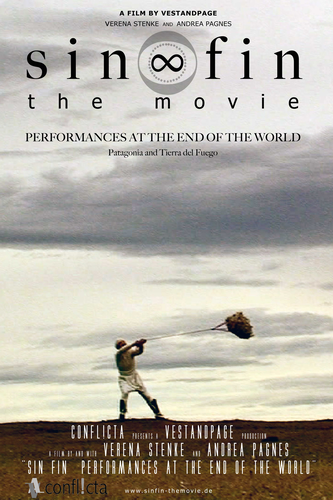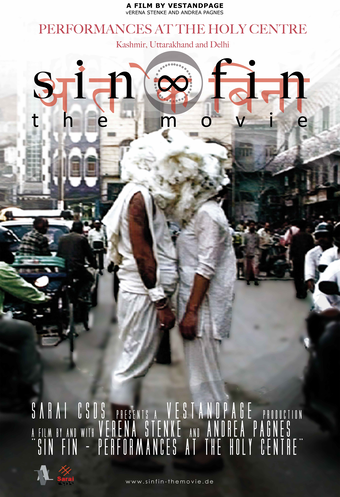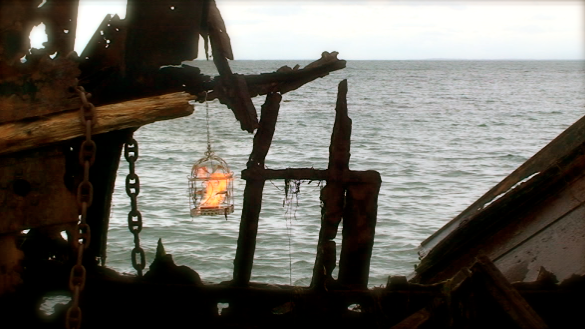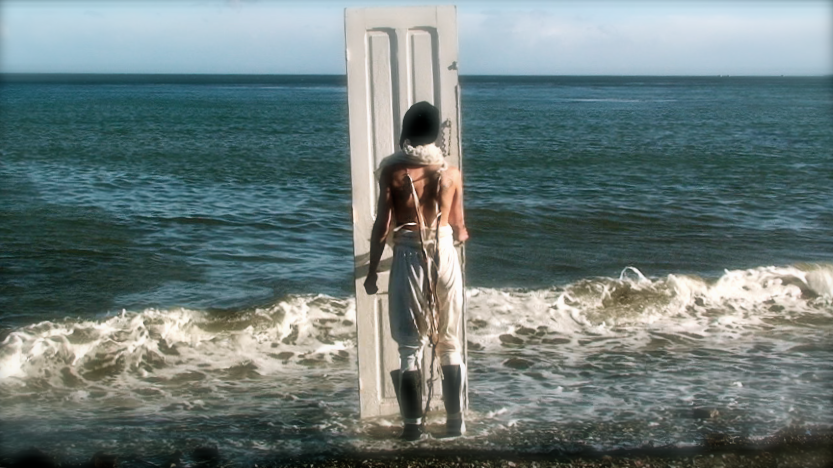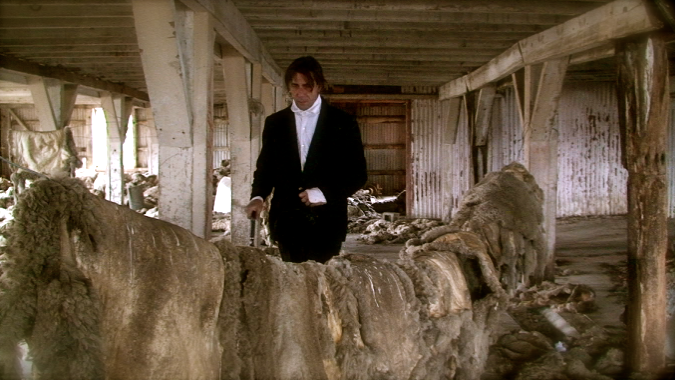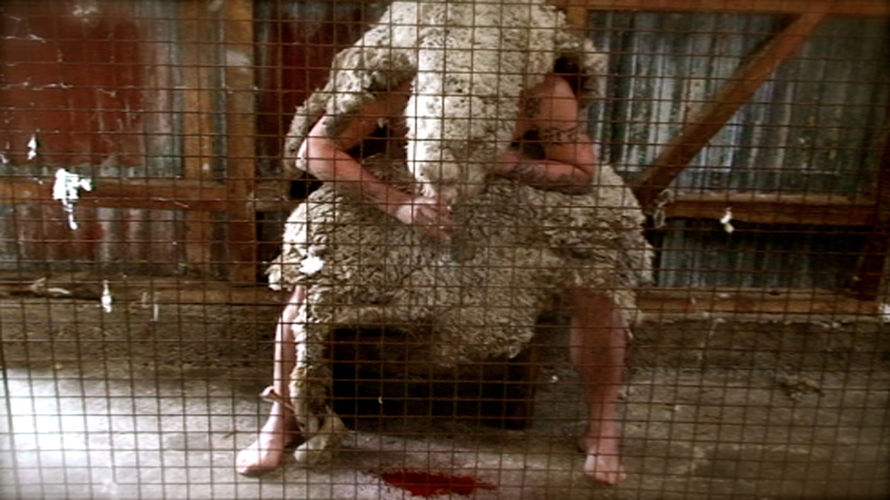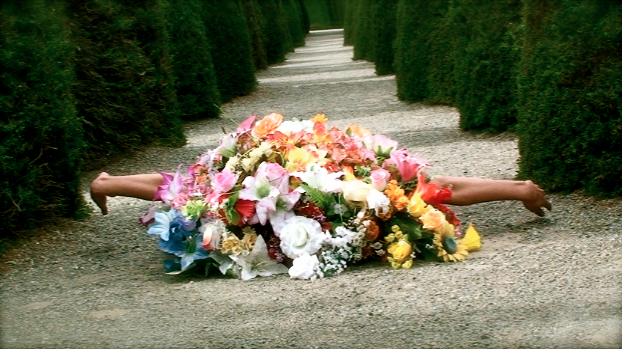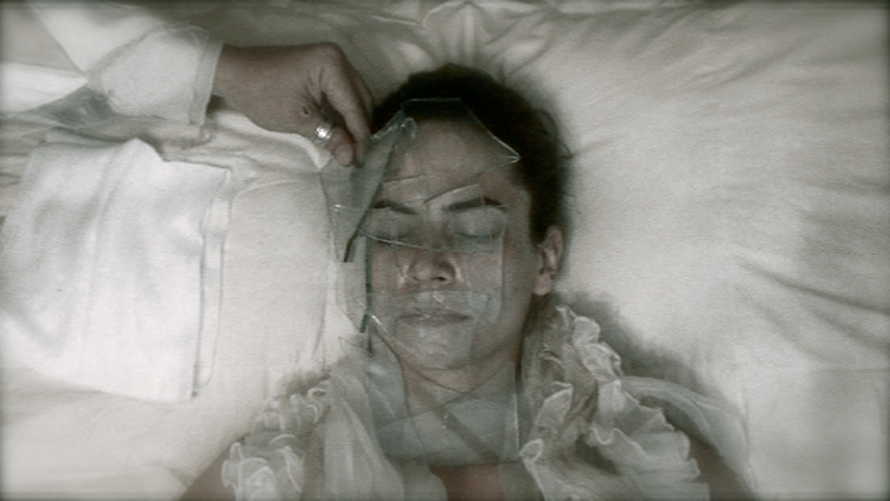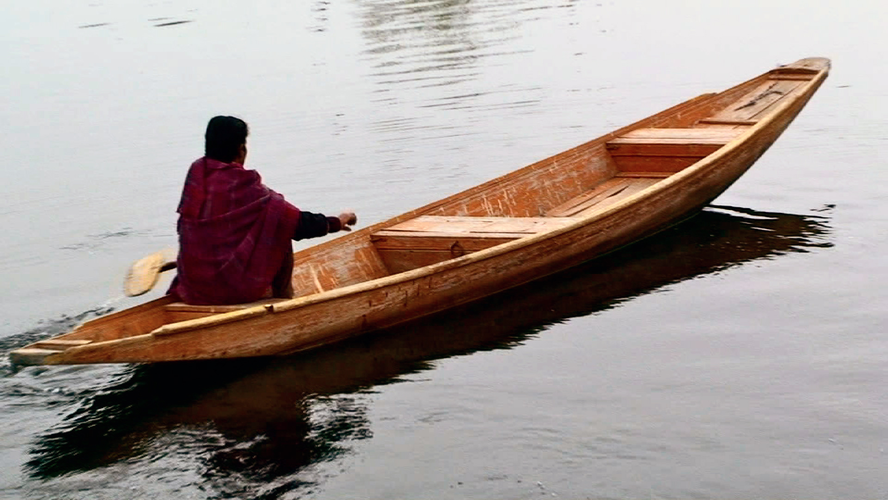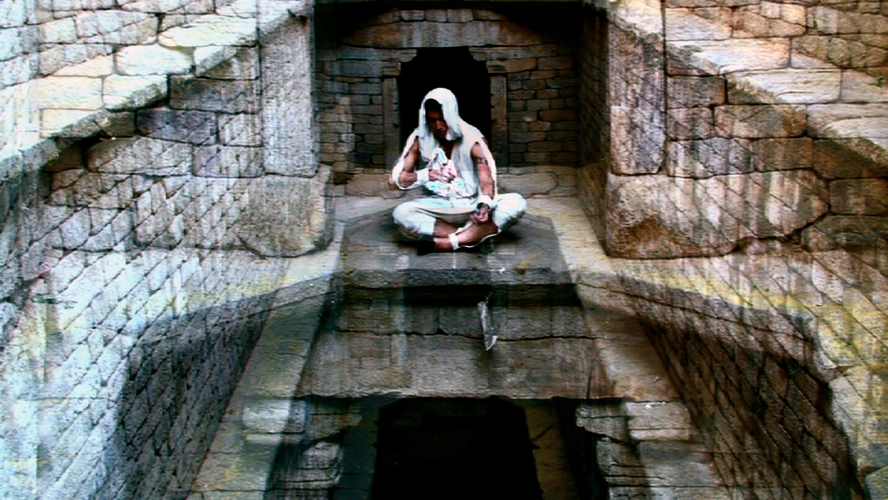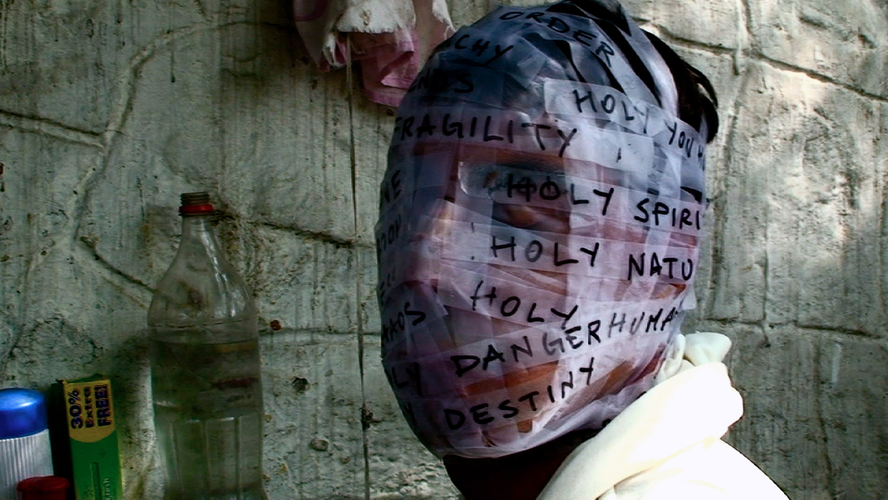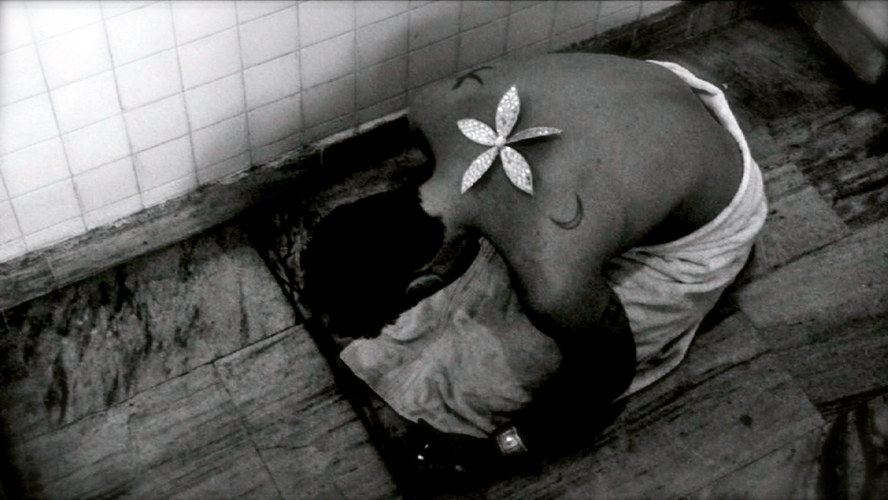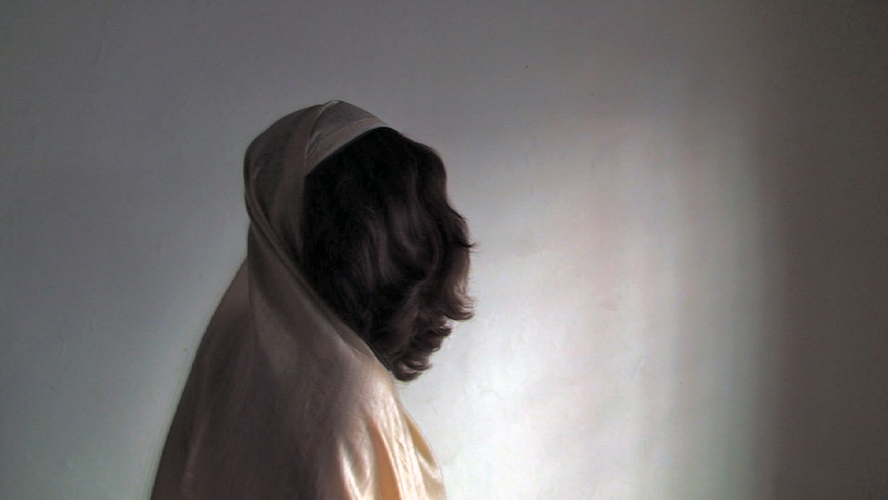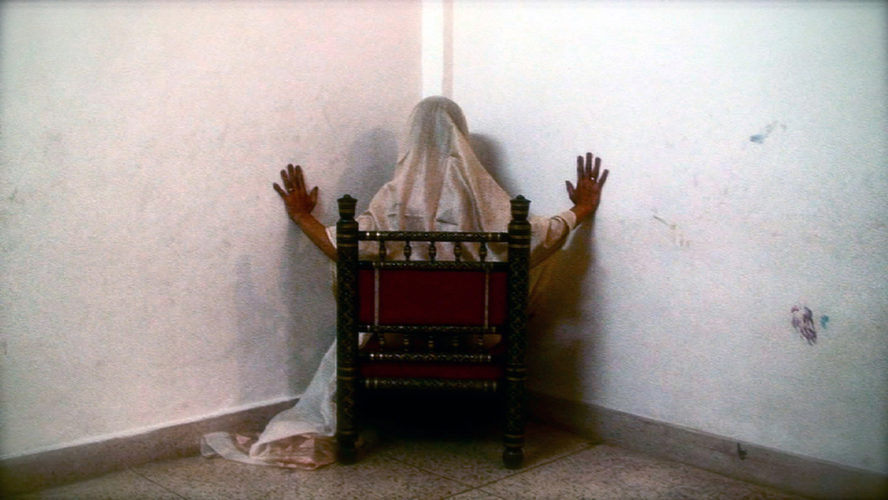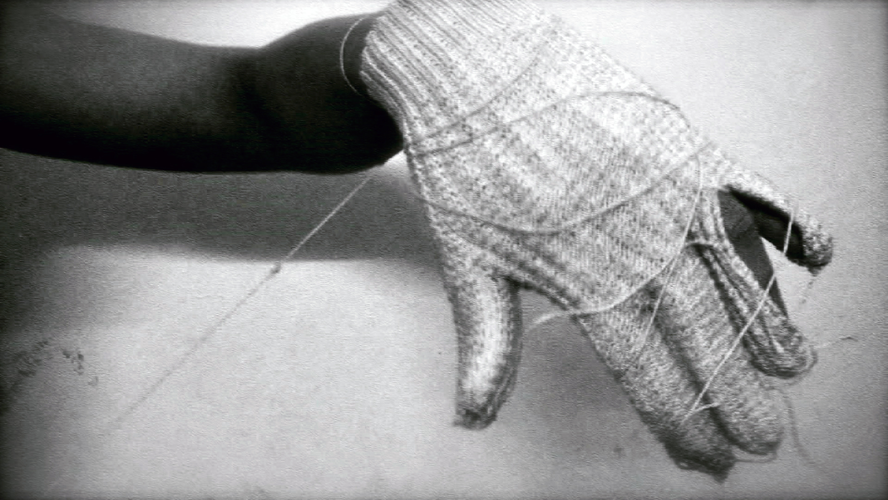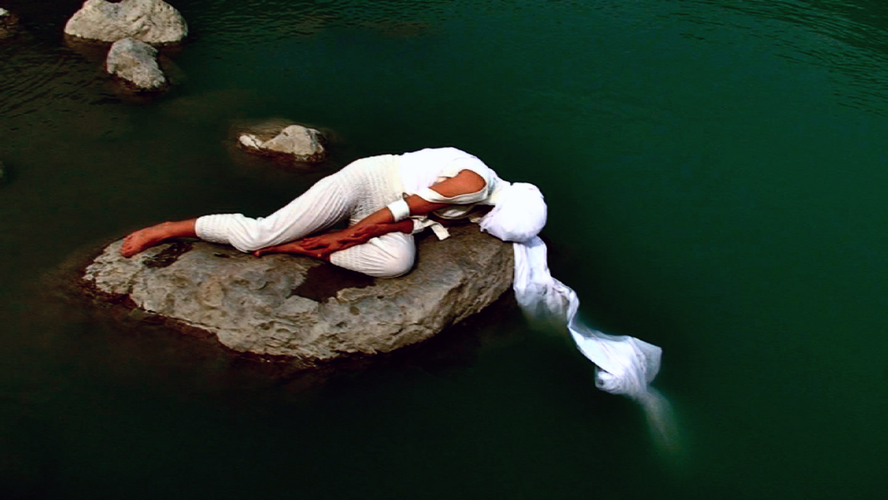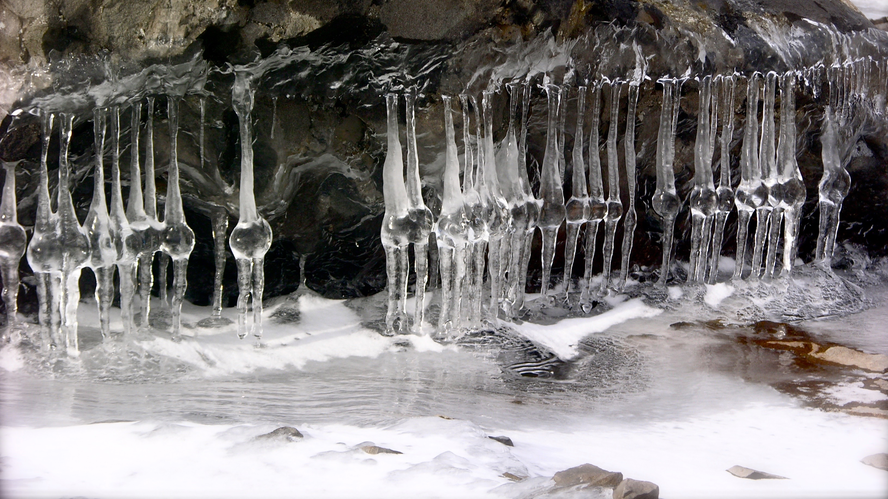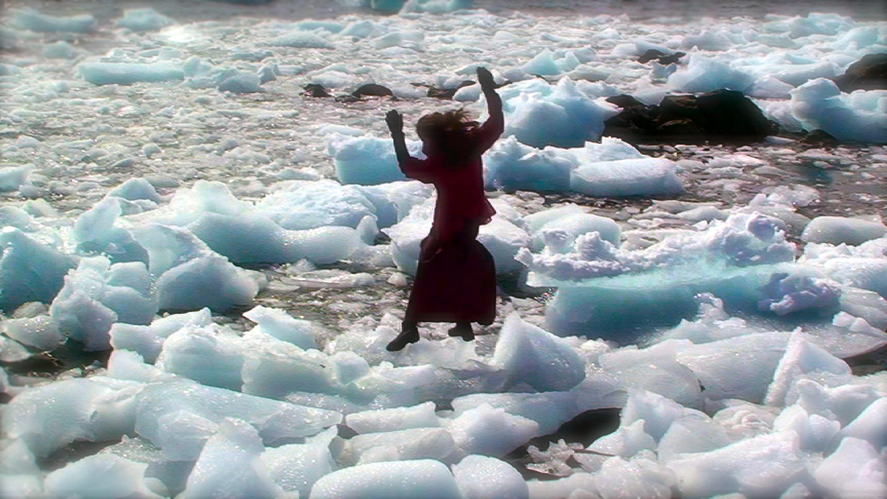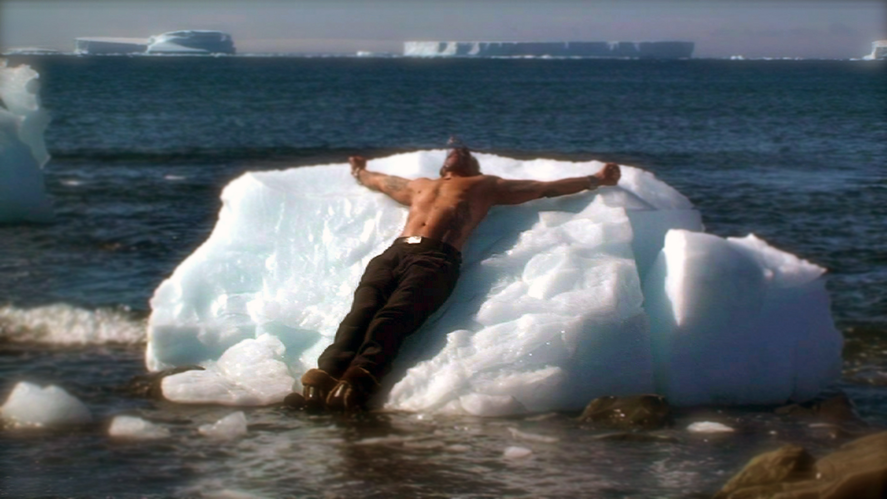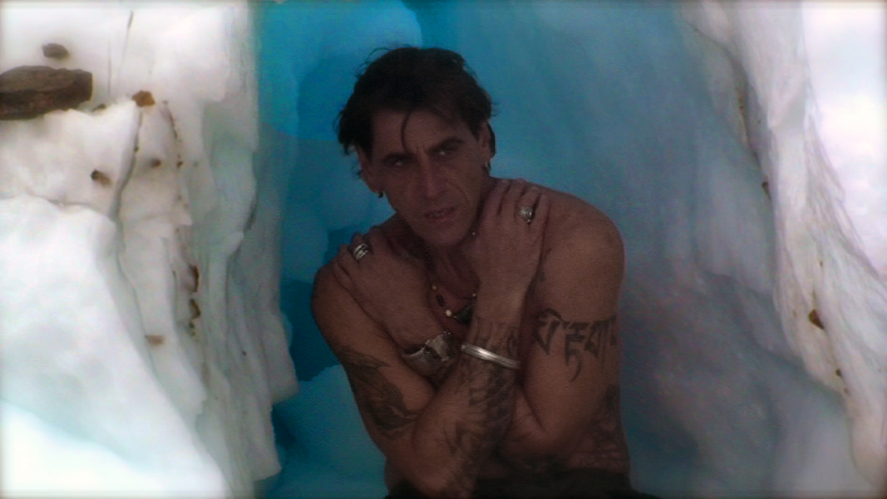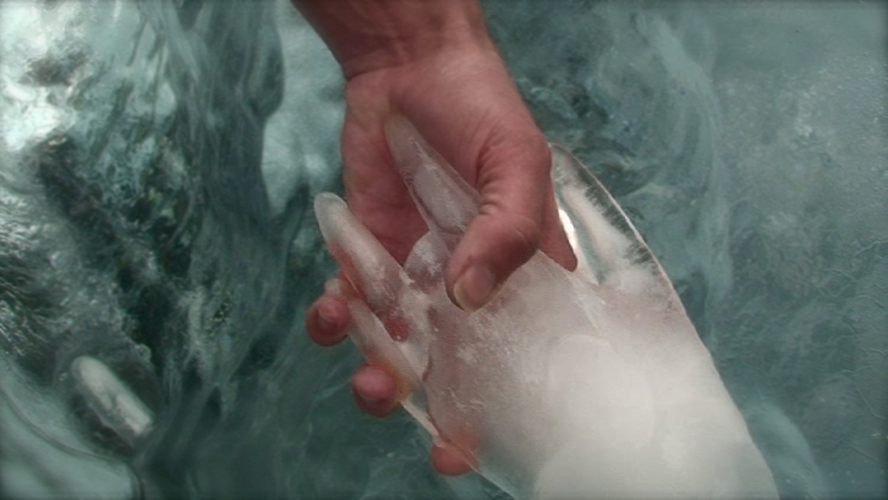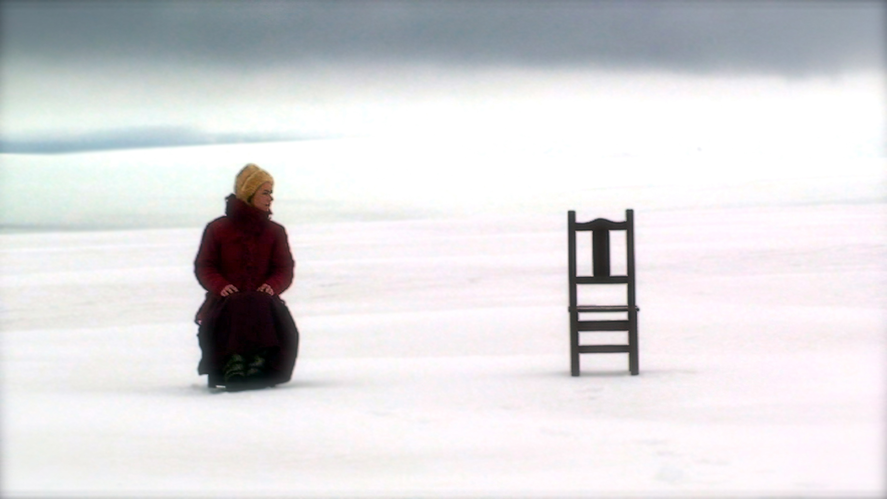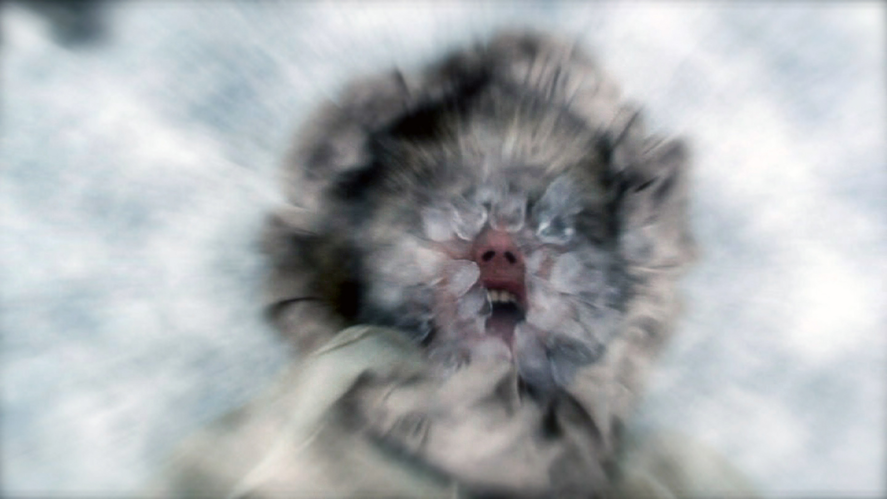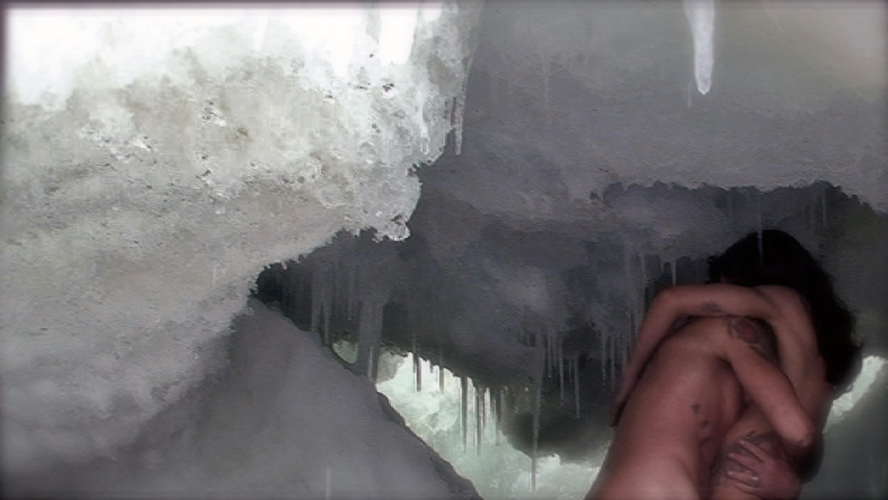Andrea Pagnes (VestAndPage)
sin ∞ fin - The Movie
A performance-based art film project
by VestAndPage (Verena Stenke & Andrea Pagnes)
Public interest statement
The present article sin ∞ fin - The Movie | A performance-based art film project is an opportunity for researchers, artists, filmmakers, art theorists and the general public to closely engage with the thought and practice that informs the field of body-based performance art combined with filmmaking.
The process of performance for camera, often within site-specific locations, represents for us – the authors – an opportunity to investigate notions of the body, memory and identity when confronted with unfamiliar environments.
Eventually, sin ∞ fin - The Movie is an experimental art film to foster discussion about the rubrics of structural interdisciplinarity in art making, its possibilities, benefits and failures.
Abstract
Inspired by Peter Sloterdijk’s investigation dissecting Micro- and Macro- spherology in his trilogy Spheres, and by Italo Calvino’s novel Invisible Cities, the moving image project sin ∞ fin – The Movie by VestAndPage is based on various stages of research to conjugate performance art with filmmaking. Its final result consists of an art film trilogy produced along the course of three years in the following artist-in-residence programs: CONFL!CTA Contemporary Art and Science Research (Punta Arenas, Chile, 2010); Sarai CSDS Centre for the Studies of Developing Societies (New Delhi, India, 2011); Cultural Program of the DNA Dirección Nacional del Antártico (Antarctica / Buenos Aires, Argentina, 2012), and based on performances conceived site-specific.
Synopsys
The performance-based art film trilogy by German-Italian artist duo VestAndPage builds on layers of images and meanings pertaining to the individual and the duality of the couple in the first episode; it links history and the sense of sacredness to contemporary society in the second one; it faces nature as a universal untamed force and prerequisite for life, which looks back at us as its opposites – rational beings - with empty eyes, in the third one.
Episode 1: sin ∞ fin - Performances at the End of the World
In December 2010, the first episode of the movie trilogy: sin ∞ fin - Performance at the End of the World, was produced in Chilean Patagonia and Tierra del Fuego, in co-production with CONFL!CTA Contemporary Art and Science Research (Punta Arenas, Chile). It premiered at Imago Mundi in Punta Arenas in December 2010, and two months later, in February 2011, officially at the X° Patagonia Film Festival (Puerto Natales, Chile).
In this initial episode, we filmed through the rooms of houses and lodges that have no address as two Jedermann humans. These architectural spaces are the spatial forms from which our performative actions develop and the scenic elements that metaphorically represent the imaginary structure of interior spaces, stuffed with volatile visions, liquid memories, fragments of personal life stories and forgetfulness. The aesthetics of dreamlike sequences combined to the harshness of the Patagonian environment situated al final del mundo (at the end of the world) and the experienced quotidian reality, coincides with the feeling of loss of culture and tradition that this land has witnessed through the last centuries, referring to the extinguished cultures of indigenous people such as the Selk’nam, who were the first settlers. Patagonia, as the name reminds, might be described as a hybrid of pathos and agony, a sentiment in general solely felt by those at distance. This peculiar “Magellan feeling” - as the inhabitants of this land call it - permeates also Chilean novelist Francisco Coloane’s Tierra del Fuego (1956), an inspiring book that helped us to understand the forceful melancholy and spirit of a place that is at the same time severe, beautiful, cold, treacherous, desolate but symbolic of the ceaseless drama and inner conflict of the human soul. This episode says of the continuous disintegration and consequential transformation of beings and the couple, while permanent strong winds and backdrops of wideness and solitude speak of a unique nature, imbued by mystery and surreality, inside which the human needs to constantly adapt, searching for a home to take shelter.
In co-production with CONFL!CTA Contemporary Art and Science Research, Punta Arenas
Chile / Italy / Germany, 2010
DVD PAL, color, 00:38:52, 16:9, English with Spanish subtitles
Concept, Performances & Video: Verena Stenke, Andrea Pagnes
Editing: Verena Stenke
Text: Andrea Pagnes
Text Assistance: Matthew Benton
Spanish Translation: Carmen Gloria Contreras Soto
Music: Lola Kiepja sings Selk’nam (Ona) Chants of Tierra del Fuego, in a recording of Anne Chapman
With the support of: Museo Regional de Magellanes dibam, Cemeterio Municipal, Charles Darwin College, Punta Arenas; Estancia Los Copihues, Tierra del Fuego.
Episode 2: sin ∞ fin - Performances at the Holy Centre
The second episode of the movie trilogy: sin ∞ fin - Performance at the Holy Centre, has been produced from mid February to April 2011 in co-production with Sarai CSDS Centre for the Studies of Developing Societies (New Delhi, India), and premiered there in April 2011. The scenes were filmed in Uttarakhand, Kashmir and Old Delhi.
In this second episode, the deserted timeless rooms of the first episode give way to the lanes of an imaginary, oneiric city. Yet dramatically real both in macro and micro aspects, where we continue to wander as two Jedermann humans, searching ineffable and invisible remains of sacredness. Entangled in spirals of excess, loss and overflow, surrender and existential doubts, we struggle to avoid confining ourselves into a meditative bubble as passive acceptance, or a ploy of superficial adaptation for self-preservation in exigent, often unreadable circumstances. In the quest for our personal definition of what is a “holy centre”, we deal with prosaic realities of Northern India, witnessing society and its conflicts, experiencing conditions outside the occidental norms. Confronting ourselves with the sense of what we perceived as irretrievably lost, we appear as if contained inside scratches of walls, or drift along road surfaces. Other times we mark abandoned locations, deepening the margins with gestures and practices. India appeared to us like a giant womb where everything blurs: an intricate endless maze without an outside, and with an inside composed by textures and edges of a spatial multiplicity, as if it were a kaleidoscopic web. Here acts are centrifugal, and remembrances splint all over the ground, waiting to be picked up, or maybe simply to rest for a while, after having travelled so far. Circulating, inscribing, and seeing ourselves as strangers who are drawn to stop by, in the process of adding our stories to others, we deal with our bodies’ inertia held by the tentacles of undefeatable traditions. Unrevealing and revealing is accretive. Meanings, signs, which are layered over ruins and history’s dust, are peeled off one by one to be reconnected and mapped in the atlas of a fragmented time.
In co-production with Sarai CSDS Centre for the Studies of Developing Societies, New Delhi
India / Italy / Germany, 2011
DVD PAL, color, 00:37:14, 16:9, English with subtitles in Hindi
Concept, Performances & Video: Verena Stenke, Andrea Pagnes
Editing: Verena Stenke
Text: Andrea Pagnes
Hindi Translation: Rakesh Kumar Singh
Music: Kassim Bayatly, Verena Stenke
Trailer Music: 49 percent by diF_ ISh S and Konrad Bayer
With the support of: Inder Salim; SSARL, Srinagar/New Delhi; Shankar Barua and The Academy of Experimental Arts, New Delhi; Arun Metha.
Episode 3: sin ∞ fin - Performances at the Core of the Looking-Glass
The third episode of the movie trilogy: sin ∞ fin - Performances at the Core of the Looking-Glass, has been produced in Antarctica from late January to late February 2012, and edited in Buenos Aires on March 2012 at Residencia del Sur. Realized in co-production with DNA Dirección Nacional del Antártico, Buenos Aires and Thetis Spa, the episode premiered at CCEBA Centro Cultural de España in Buenos Aires on April 04, 2012.
Surrounded by the Ice, the intrinsic journey of the two of us – wayfarer Jedermann humans - comes to its end. We move through the deserted icy vastness dreamily, to find ourselves fragile creatures being torn between life and death, absence and misleading mirages, fortune and emptiness. Within a flux of nature so mercilessly immense where the winds blow their laments and silence is their lullaby, Beauty is nothing but a mirror and haven just evanescence, although attracting the human spirit as an apparent but dominant force that acts outward on the body, arising from the body itself. And in this blankness we forged our questions, wandering East, North, West and South searching for it, for that elusive out there which seems certainly to contain our answers. Is there any game left to play with? Is there someone left to call for, when clocks don’t display time anymore, and no compass is guiding one’s way? Who’s the player and who’s the pawn, and whose turn is it, when civilization has lost its quotidian schemes, when primordial rules are the only ones that count? If we are all pulled up by a magnet, how can we believe to be possibly free? In the backdrop of this frozen continent, a place where humans have neither roots, nor future, but only a frail and temporary presence always at risk, all questions inevitably lead to humbleness. Investigating and performing to confront the comprehensive sphere of nature and universe with our own human and private one, this final episode of the trilogy represents also the culmination of our three years long-standing research on the subject Spheres, searching to establish a dialogue between our concerns, worries, and artistic issues through a hybrid mode of artistic expression.1
In co-production with DNA Dirección Nacional del Antártico, Buenos Aires, and Thetis Spa, Venice.
Presented by Zonadeartenacción, Quilmes and Residencias del Sur, Buenos Aires.
Argentina / Italy / Germany, 2012
DVD PAL, 00:45:42, color, 16:9, English with subtitles in Spanish
Concept, Performance & Video: Verena Stenke, Andrea Pagnes
Editing: Verena Stenke
Text: Andrea Pagnes, Laura Bucciarelli, and Aisha Ryannon Pagnes
Text Assistance: Gaston Lacombe
Spanish Translation: Roberto Ruiz
Music: Zai Kuning, Angie Seah, Black Sea Hotel and recordings of Weddell seal callings under the ice by the courtesy of Douglas Quin.
With the support of: Secretaria de Cultura y Educación, Quilmes; Departamento de Extensión Cultural EMBA, Quilmes; SPIN-Conectora Cultural, Buenos Aires.
Preamble
What are we at the present time? What is this ineffable energy that goes beyond and above structures, norms, stale intellectual boundaries and canonical traditions, moving on going, turning through any space, characterized by indeterminacy and the emergency of the unexpected? How do we - as performance artists - handle our individual creative stamina when facing new and unexpected challenges, allowing it to travel as boundless energy, or when just closely observing our own performative acts of knowing, understanding and making decisions? What is the sense of creating, liberating, reuniting within performative arrangements beyond art itself, for example in places where our logic no longer serves a well defined purpose? What to do with these bodies we have that sometimes when we perform we no longer feel as “ours”? How can we translate these concerns into a living and moving images?
Mattering, sensing, questioning, problematizing and comprehending: the relationship that a performance artist establishes with a concern, surrounding, or the other, is often the result not just of a mere attraction or personal choice, but rather of an entangled encounter arising from the necessity to investigate into processes of understanding and knowing. Eventually, the entangled encounter performance artist-concern-surroundings-otherness offers opportunities to turn forces and forms upside-down/inside-out, mirroring the uneasiness that the performer senses around him/herself, both in the individual/private and social/public spheres; possibly adding new meanings to past meanings, or conversely bringing into new ways of meeting nature, people, the Self, one another as members of a complex global community.
Magnifying the motion of this ineffable we perceive (or even presume to perceive) both as mystery and life fueler through our bodies by placing patterns and fragments of performative doings under the lens of the video camera, is like operating with a microscope to intra-actively analyzing and finding a new sense of the results of our actions in relation to form, space, time, senses, voices, and every day practices - in order to re-generate the way we look at things.
What prompted us to undertake this art experiment - to conjugate performance art with filmmaking - is further our intimate belief that there is an ideal beauty crowned by nonsense, paradox, absurdness, grief and love “that is harder to define or understand, because it occurs not just in the body but where the body and the spirit meet and define each other. And we don’t know if it has any rules.”2
Introduction
“Sanity is nice and quiet, but there is no grandeur, nor true joy, nor the terrible pain that tears the heart.” (Yoram Kaniuk)
The basic assumption, which animates the trilogy project, is that life is substance of form, capable of transforming itself also into a pure dream matter to redeem the psychophysical aspects of our own individual reality, likewise inhabiting a lucid dreaming. The argument is what is associated with the old and respectable expression “sphere” borrowed from philosophers and mathematicians (Kant and Descartes for instance), suggesting that life, the formation of spheres and thinking are different expressions of the same thing. The reference to a spherical geometry is meaningless if it does not include the vital assumption that human life wherever you are, whether nomadic or sedentary, gives birth to new habitable globes, may they be touring or fixed. Love stories are stories of forms; each union is a constitution of spheres, and creation of interior space.3
The investigation, which led to the realization of the trilogy episodes required that we found ways to be equal, without antagonism, to become a pair, a dyad, a bipolar form along the sequence of our performative actions, despite given biological differences of two apparently opposites (male/female) in their bubble of intimacy. By challenging ourselves in a multiplicity of ever-changing places, confronting cultures and circumstances, we tried to perceive and define simulacra and sanctums: encounters, collisions, creation, destruction, transformation of the inner, private, social and universal spheres, in a constant path of conciliation with our own Self.
The spatial distance - both physical and imaginary - which separated us before from those faraway places gave us the feeling “to live somehow beyond the border of our times and threw into relief our temporal, social differences that interrupt our collusive sense of cultural contemporaneity”4, at the same time opening itself to us as a dimension of intervention where performativity could act in meta-reality. The fact of moving as displaced individuals and as a couple between cultures – thus temporary – has meant that our own search for identity took on the characteristics of a work in progress, a disappearing act. In our work we refer to a spatial form as an apparatus through which identities are established and social and interpersonal relations are articulated, a dimension of discovery to prove and test our capacity to understand, sustain, protect, and perpetuate our identities and relations for what and ‘til we can.5
The attempt was to examine the spherical amorphousness of the surrounding and the being, by fathoming universal human experiences through the prism of an extreme environment in Antarctica and Patagonia; in Kashmir witnessing the socio-political situation (where you can count one soldier for every two inhabitants); in Haridwar and Delhi’s outskirts, wandering among hills of garbage, suburban chaos, and the silent survival of millions people poverty stricken, to gradually disavow our suppositions, beliefs and Western hypocritical convictions.
Taking the familiar and staging it within epic, alien or unimaginable landscapes, “the result of performing only for the video camera is a heightened reality: both entirely surreal and as familiar as a dream.”6 Being aware of the fact that the prominence of environments could have prevailed in the images, to find a balance between our presence and the powerful surroundings we approached the geophysical status of us as individuals performing in the here and now with a poeticism as evidence of our subjective position. We searched to metabolize the sense of being lost in every place and then perform it: as to be lost was what we felt wherever we were.
Poetry and literature helped us in the preparation of all three journeys and along the trilogy’s realization, besides the historic, political and scientific readings related to the different places and cultures. Poetry and literature mirror exemplarily spiritual and existential concerns, which can be transformed visually. In terms of how we tempted to create moving images, poetry has allowed us to have a more lyrical approach through the artistic process. It privileges the imagistic to the didactic, posing open questions that don’t ask to be resolved immediately, for they have their own life, and as they are born they may also over time cease to exist, thus not requiring sought for or even forceful answers.
Trespassing into the realm of the ‘anew’ induced us at first to relate instinctively to ordinary rituals, habits and things, probably for the need to rely to something comfortable, already known, only to realize thereafter that by doing so we were just imbuing ourselves into too personal paradoxes. However, the progressive detachment from our comfort zone brought benefits in terms of expanded creativity, because it didn’t allow our rational mind and cultural schemes to abuse fictitiously of those places unknown to us, wherein now we were. When we encountered situations apparently indifferent in themselves, incomprehensible or static, or which seemed impossible for us to enter into, we allowed ourselves to mistake, hazard, to the extent of putting ourselves at high risk, thus trying not to be invasive and to finally transform failure into a positive creative force.
The production schedule of the single episodes was held tight: one to two months for each. Finishing the production residencies with consigning the completed episode work, we considered important to keep the spirit of those places until the conclusion of the process, even while editing the material, and to put an end to it while being still there. One could always improve, change, consider and re-consider the editing, but our approach in the filmmaking is just like in our live performances: what goes, goes, and is what it is, remaining as such. We didn’t touch the editing after we had left the residencies. We have decided to leave things as they have fallen into place at that time. We can’t erase errors in life and film can work this way too. It is a matter of acceptance and of surrendering to what we have found and, if anything, pass it to others who will watch it just as we have found it.
Finished the first episode in Patagonia in 2010, we didn’t know yet where the second and third episodes were going to be produced. We had to search and apply for possible occasions to produce. We applied and have been granted by an artist-in-residency at the Sarai Centre for the Studies of Developing Societies in India, a suiting place for the focus of the second episode: the social, the sacred and the religious. Still, after having finished the second episode, we didn’t know where to realise the third and final one, though it was clear that it would have to be an extraordinary place as the subject of this conclusive episode was nature and the universal. Once again things have fallen into place, and for an impressive series of coincidences the opportunity came up to apply for a one-month production residency at an Antarctic military base, as part of the Cultural Program of the Argentine National Antarctic Direction initiated and run by Argentinean artist Andrea Juan. The application process and the bureaucracy procedures were complex, and we kept our hopes small. It was only in late November 2011 when an email arrived: “In six weeks you’ll leave with a military plane from Buenos Aires to Antarctica to stay there for one month or more. You better get ready." Two weeks later, while still touring in Bangkok, we received a phone call that Verena’s father had died unexpectedly. We had to immediately go back to Germany, while at the same time preparing ourselves for the journey to the South Pole to start producing the final chapter of the trilogy. A lot of once-in-a-lifetimes came together in these dense few weeks.
A performance-based art film project
“There are no expectations; there’s no script. When you’re doing what you love to do, you become resilient, because you create that habit.” (Dick Costolo)
In order to realize an experimental film outside any filmic genre based on the ephemerality of performance art such as sin ∞ fin – The Movie, site-specific actions and installations were conceived in the moment, chosen to respond directly and genuinely to circumstances and places in which we found ourselves. This could allow us to move freely between the factual reality and the realm of vision offered by those locations, places that had before exercised a strong influence in our imagination.
Shifting between those two dimensions (reality and vision) is effective for performance because one perceives what is unordinary. It stimulates sensorial and spiritual activities, especially when one finds oneself in unknown places and situations. In this, we also triggered reflection on our common, conflictive contemporary situation, as artists as well as individuals, to investigate the sense of loss when coming across unfamiliar factors (not only environmental), and not to slip into a mere contemplative state that might have led to a too passive acceptance.
In Patagonia and Tierra del Fuego we enforced our ‘mode to perform’ by seeking the causes of the extinction of the natives Selk'nam and their culture due of Western colonization, through publications that the Director of Maggiorino Borgatello (the Salesian Society museum of natural history of Punta Arenas) introduced us to. We read Chilean novelist and essayist Francisco Coloane. We got acquainted with the issues of depression, alcoholism and mental illnesses that afflict the inhabitants of the little town harbour of Porvenir in Chilean Tierra del Fuego.
In a land of such rare beauty such as Kashmir, we became aware of the atrocities of ethnic cleansing - the Kashmiri Pandits massacres and exodus – recounted by a group of survivors, exiled in a refugee camp which we have been invited to visit in the neighbouring province of Jammu. Their stories influenced the second episode of the film trilogy to the extent that the final speech closing this episode is actually a young Kashmiri Pandit girl’s speech of conciliation.
In Antarctica, an immaculate continent not made for human life, Argentinean scientists and military taught us that down there there was little to be romantic, as the hands of the superpowers ready to exploit it are already hovering everywhere. To live on the ice means to spend most of the time caring about mere survival. To produce a work intellectually and poetically honest, we couldn’t cease to the enchantment that the sight of such unique and disruptive nature inevitably caused to the eyes. It was instead necessary to enter on the contrasting human feelings of the few people that were living, working there and hosting us: which kind of relations had they built with this land?
Hence, brought into contact not just with the beauty of such places, but often with a more obscure and unspoken side of their realities, living together with the residents, listening to their life stories, exerted an influence on our way of performing and the development of the film.
To combine performance art and filmmaking was because the question of the ephemeral nature of performance art and its documentation has always been a crucial one for us. Producing where we would not have any (human) audience witnessing any possible live performance, and the body being still our main medium, this apparent conflict became the opportunity to search for alternative ways of production. It was not tempted to organize the trilogy into a coherent unity of identifiable actions, but as a body itself, which could function as a system of moving images capable to produce connections and to distribute varying intensities mutually transformative, both for us, and a future possible audience.7
On matter of cinematic philosophy, the work of directors such as Ron Fricke, Godfrey Reggio, Robert Cahen, the rejection of narrative schemes and trust in the visual intelligence of the viewer, has been determinant to our choice. Likewise Vito Acconci’s Indirect Approaches (1973), in which the question of the “medium” is raised. For those directors and artists, as well as today in the work of Isaac Julien, the “fragmentation of cinematic linearity is accompanied by a concern with creating new possibilities in artistic experience, an aspect made clear in the way his visual experimentations have gradually subverted the pattern of creation and fruition in cinema.”8 To acquaint a performative quality of the poetic image on film, the experimental super-8 films Derek Jarman started making in the 1970s have been a source of inspiration. Exemplary have been also the principles of the Dogma group and the oeuvre of Werner Herzog, with whom we share the believe that art does not need thousand of dollars funding for being good, but a vision, the guts to follow it out of a profound urgency, and the commitment of placing oneself in dangerous situations to search for new images.Technically, Pier Paolo Pasolini's almost predominant, anti-virtuous use of the fixed camera with long shots to reach the zero degree of the image – the ‘pure’ image as he used to say – helped us to reject sophistication. The particular way of Alejandro Jodorowsky of structuring metaphors taught us to translate poetry into moving images with a dense expressive economy. To resolve our aesthetic concerns with filmmaking, the lesson of the performance film work Die Klage der Kaiserin by Pina Bausch (1989), or Rebecca Horn Buster's Bedroom (1990) have been a real guidance.
Not interested in glossy or glamorous filmmaking, nor working with a team of specialists or an expensive production structure, we were instead interested to explore what happens when two artists with different backgrounds in the visual arts, theatre and creative writing decided to use the camera as an additional medium to see, translate and express their artistic and human urgencies, keeping true to the core of our main artistic expression: performance art.
As in our live performances, the trilogy searches for the essential quality of spontaneity and authenticity that is intrinsic to performance art. All of the three episodes’ actions were neither staged nor prepared (as i.e. in Matthew Barney’s exceptional Cremaster Cycle). They were instinctual responses to the surroundings and have never been repeated twice but shot on site and thereafter only edited basically. The settings comprised mainly of what we found on site during production. No artificial lightning or post-production effects were applied. And so it was a natural consequence that the final editing had to follow this line of authenticity; sounds, cuts and the overall final flow echoed this tenet. We adapted principles of performance art to the cinematic technique itself. The choice to experiment on the ridge of the ephemeral meant that we would have to leave the entire methodology of execution of the trilogy follow the process, work in progress, shifting of perspectives and finally life. There was no script or storyboard because we wanted each action to develop in direct response to the surrounding: planning was possible only up to a certain degree and in very few cases. The outcome of this methodology is that the actions recorded by the video camera form single moments shaping an organic cycle of moving images with an autonomous non-linear story, and that consequently would be read by the viewer in a personal way: fragments of time to be skewed and prepared at one’s own choice and will.
We reciprocally recorded our actions, or left the video camera on a tripod to statically record what we were performing and what was happening around us. In this way the camera’s eye saw what a possible spectator, witness of that action, would have been able to see. Zooms, close-ups or shifting angles have been rarely used. The editing is reduced to basic cuts with few means of crossovers, leaving the actions in their original time length as much as possible. The lack of color or contrast adjustments, and the use of natural sound and field recordings contribute to the movie overall performatic-cinematic aspect.
Combining performance art with filmmaking allowed us also to be led towards something previously unknown in our artistic practice: it offered us an occasion to give evidence to the notion of image as a representation of memory and an imprint of identity, where its appearance belongs to the fact of its existence in the first place.
The major concern during the making was not to put in relation the live image with technology, but to disassemble and deconstruct the recorded actions during the editing in such a way that they themselves could function as an itinerary of virtual time lapses through the trilogy. In each episode, images/visions take on the role of subtle points of departure for a journey through the sediments of memory of two restless humans that strive to return to an ideal beginning, oscillating in and out their own doubts, contradictions and questions, between signs of mortality and the immaterial, aware of their vulnerability, loss of sensorial control and shadows of life left behind, inscribed invisibly in real images that may look impossible.
To acknowledge a basic difference between film and live performance within the perception of the actual duration of an action was further consequential. In live performance we privilege extended time, preferably not less than two hours wherein the process reveals itself within time passing. In film, the process is unveiled by finding links between pieces and actions that seem apparently disconnected. A film work is like a worm-whole, where space-time deludes in trivial boundaries. Sequences can be changed, and time shortened or prolonged; there is no continuity whereas a live performance is strictly linear due to physical limitations in time and space. If we liken our live performances to alchemical processes, our films are its metaphysical attempts. To match the two might implicate an explosive theory of perception. The use of the video camera took us one step further in the attempt to make the invisible visible, rendering dimensions that we cannot easily access in the factual realm within which we were moving.
Paradoxically, filmmaking with performance art enabled us to enter even deeper into the substance and impact of an action, though mediated through two-dimensional, immaterial moving images; however because of its non-linear qualities, shifting perspectives much more than a live performance probably could. It is often being talked about the transformative quality intrinsic to live performances, being actions ‘lived on the skin’ of the agent/executor (the artist/performer) as well as the audience or any participant. Whilst this direct skin-to-skin/sight-by-sight sensation is inevitably lost in a film, it gets substituted by an over-dimensional quality, which allows to access reality with different eyes and to question the perception of it as such. Applying this methodology to film became natural, activating a climax close to the state of dreaming which is strengthened by the ephemeral quality of the medium of performance. Ultimately, both techniques question perception of reality and of the being within reality, while at the same time they offer the access to an endless field of discoveries, unthought-of connections and creative possibilities.
Working primarily context-specifically and site-responsively we avoid conceptualization a priori that could derail us from the anthropoetic approach we privilege in art and life. Questioning us in the here and now for an ideal authenticity, and inclined to think that all things specifically human can be traced to a common origin (yet unknown), we tend to reduce any personal or private intentions to a minimum degree, opening up to be influenced, informed and hence to discover. The inner compasses mark the stepping-stones for the journey, physically, spiritually and artistically. For each action that took shape along this creative process we firstly had to inquire what this action actually needed in terms of time and space to communicate its core at its best: is a simple photograph enough to express the meaning thoroughly, or is a moving image needed, or is it necessary to perform live in front of/with an audience? Eventually, it became more a matter of choosing ‘where’ to do it, and not ‘what’ to do.
Once the individual actions and moving images could stand alone as metaphors, either with or without a direct audience, the sequences were pieced together, likening the composition of a self-generating abstract musical score whose silences are as vital as its notes. Additional layers were added to the merged action/video material through field recordings, readings of stream-of-consciousness writing texts and re-awakened quotes of writers, that during the process had been echoing inside us. Mainly informed by dreams and remembrances, as this is how we work within the realm ‘too far too close’, we linger between reality and yet another subtler veil of reality to foster new images, wherein philosophical and literary backgrounds are of paramount significance.
In the second episode of the trilogy produced in India and Kashmir, the scenes filmed in the ruins of the archaeological sites have a symbolic value of transience, also linked to the nostalgic feeling of an unrecoverable time. Obviously, there is something evidently evocative in all of this, perhaps for the ideal of a Civitas Metaphisica that has been lost and that basically never existed and even if it would have existed, in our eyes it now appears irreversibly devoid of its identifiable topographical elements. Those places, though they may appear enticing at first sight, are ‘emptied’ and unreal; almost like a Theatrum Mortis spectral fifth. As an inevitable result, the documentary objectivity can only leave space to a new vision of poetry as its progression unfolds and reassembles reality, coexisting with our imaginary visions and inwardness.
This is also evident in the first episode filmed in Patagonia and more so within the third one in Antarctica, because in these uninhabited spaces, any idea inevitably occurs far away from the ordinary world and daily concerns. The stinging sense of melancholy and astonishment, the tangible realisation of the human frailty even just for the mood of an unpredictable extreme weather changing, solitude, silence, emptiness, merciless ruthless beauty that shines from a nature so immense and desolate, come to reify this complexity of feelings in dreamlike visions: a pulsation of life.
A task was being mindful of how our own positions might be identified within of the context of these lands, in relation to the history of European colonialism, exoticization of the other, and others. While trying to strip down actions and reactions to a most human, universally accessible code, we had to be aware that each context had its own peculiarity, and that in any context the human factor (one’s own and that of the other) plays a determinant role. A live artist provides with its mere presence and cultural background the addition of the human factor to the spatial, temporal, social and cultural context where s/he operates.
The issue of identity and the delicate mechanisms of a subsequent out-of-context identification of origin in a foreign land have been most clearly experienced while working at the second episode of the trilogy in India and Kashmir. Witnessing social circumstances that we had previously accessed only through Western information, we had to abandon any presumptions to work uncritically. The challenge became to not apply any culturally conditioned prejudice, mind set and politically or historically imposed schemes, though still responding to the intrinsic sensations of what the lived and saw provoked. It was a like walking on a tightrope or vaulting on a balance beam continuously. Probably this episode was conceptually the hardest to realise. As a Buddhist saying goes, to practice like earth, to receive without resisting, complaining, or suffering; like the water, receiving everything equally “without grasping or aversion.”9 So yes, this was our task.
Especially within collective contexts we encountered moments, in which the clash of cultures and identification occurred. While shooting the scene of both standing face to face to each other with our heads covered in one cloud of silk, among the vivid traffic of one of the busiest streets of Old Delhi, we didn’t consider that this action could be perceived as a strong provocation. Our attire was decent, but it became apparent to the mainly male passers-by that their interpretation of our action was contrasting of our intentions. They weren’t concerned that we might create impediments or distraction to the flow of traffic: they supposed that we were kissing beneath the silk cloud on our heads, and that this offended the God/s. Jama Masjid, one of the oldest and the biggest mosque of the country is just some street away, and our presence was unwanted. Some got heated enough to throw stones at us. We heard our friend assistant Vikash who accompanied us on site discussing in Hindu with the crowd and then saying: “It’s better to go, now, quickly.” Our naive unknowingness on one side and the strong excitement provoked on the other, ended shaping this simple scene more than we could have conceived beforehand.
Similarly dressed, shooting in one of the most beautiful abandoned stepwells of Delhi (Gandhak ki Baoli) close by the archaeological sites of Qutb Minar, taxi drivers and families silently watched the whole scene. Later they approached us saying: “Thank you. You must be very good people. You are dressed and looked acting like two saints to us all.”
Urban and social contexts and cultural and religious symbolism are matters that open into discourses. Although we work mainly with our own cultural connotations, we also continue to learn in every new place. ‘Authenticity’ is what counts the most here, as the above mentioned situations show that life provides a much better script or concept than any artist could ever draw up and it is life indeed that brings the most shining revelations.
Driven to explore how the spatiotemporal structure of an environment could evolve or de-evolve our creativity by responding with immediacy and in suspension of judgement, we ‘gathered’ ourselves with it into an ideal unity as pars construens of a project on human dwelling. This was possible only by allowing a process of “letting be”10, of absorbing external information uncritically, phenomenologically experiencing our ‘being in there’ to acquaint the knowledge of an ineffable essence. This approach helped us in the performances, as it un-hindered issues such as shelter or birth; whether being on a stranded shipwreck on the shoreline of the Straits of Magellan; or moving along the banks of the Ganges questioning if we too had something to offer to a sacred river so irreversibly polluted; or finding ways to tune within an hostile natural climax – these were possibilities to stress the limits of bodily resistance and sense of alertness, paying particular attention to internal and instinctual reactions.
While living in Tierra del Fuego, where the winds of the South blow constantly at a speed of 60/80 mph or more, a shepherd told that the wind carries the voices of the dead and that one could notice it only by listening carefully. For the Western sceptical mind this sounds like popular belief; but it is fairly true that living in these places wherein loneliness reigns, the wind becomes a partner and its sound the interlocutor. The sensory experience of being exposed to the steady force of the winds and tuning one’s listening to their sound for hours a day, gradually affects the nervous system, changes one’s mood, alters the sense of equilibrium as well as the way one thinks, feels and remembers. Being one of the two last males left of a so said old Spanish Marrano gypsy family, while living in Tierra del Fuego, at night I begun recollecting and writing down some stories that my grandfather used to tell me about the life of the gypsies when I was a child, something that I had never done in years. Although initially sceptical of the winds’ forces and ‘mysterious’ powers, it is these, which finally inspired me – as I like to believe. Recollection is a powerful means to transform memories creatively: one early morning I left the Estancia Los Copihues on Tierra del Fuego to reach the open fields, wearing the clown’s red nose and black feather tuba hat. I grabbed a wheelbarrow, lighted a fire inside it and pulled it up to an old disused wooden wagon. I sat on the top of it and played the harmonica. Verena recorded it.
Later she took two dozens of crystal glasses, filled them with clear water, set them on a promontory rightly in line on the horizon and we sat either ends of the row to drink them all till we met at the centre.
These became two topical scenes of the first episode, introducing displacement, improvisation, celebration and re-conjunction. On a more personal level they became a way to pay tribute and reconciliate with our ancestors by squeezing and transforming them into a performance through the recollection of my grandfather’s stories.
This modus operandi clarifies that we never thought about the film as a documentary, rather we structured it as a set of poetic images in sequence. As Venezuelan art curator and producer Ana Moreno wrote to us in a letter on November 2012, by operating as such, we “framed an immediate fleeting sense of beauty in form and substance, crudely bejewelled with a sober aesthetic, sought through an artistic process that could be subject of situations concerning life from the depths of being. This gives movement to the body, to be fully aware by being agent and witness in equal measure and what it actually means to perform harmoniously and with humility, deepening into our Self and to turn our flesh within to attempt to become one with this all.”
Retracing the body
We believe that an artistic research must also aspire to a philosophical explanation of its concept and origin. With our performances we don’t want to represent a reality, but illuminate areas of that which we perceive and see as obscure, searching ways to express with our bodies what we have and have not yet seen. (VestAndPage)
In 2014, sin ∞ fin - The Movie began its distribution through Video Out Distribution - VIVO Media Art Centre, Vancouver. In his interview with us, curator and coordinator Jeremy Todd, postulated that the trilogy could perhaps be interpreted as a kind of metaphysical dérive in relation to the actual landscapes involved, but that there's also a kind of graceful athleticism, a lyrical emotive expressiveness sited in our bodies throughout the three episodes that makes him think of modern dance.11
If we consider "modern dance" as one theory related to the investigation of movement, therefore not merely as a category or discipline of the arts, and not only circumscribed to the physical human body, but expanded to thoughts, spaces, objects and all the configuration of the things, this could then apply to us. The search for authentic expressiveness of the body is a strong element in our work, even though we do not copy, train and refine or re-produce movements as it is mostly the case in dance. In our practice of movement, abandonment and reduction are crucial. It is not about showing how good one is in jumping, but instead to communicate what "a jump" is; or the moving force that resides behind the movement that allows us to jump, and why there is a necessity to jump in a particular circumstance. The concern is not how to make that particular movement at its best, but why to make that movement at all, and if there is a need, to make it as such.
The extreme weather conditions of Patagonia, Tierra del Fuego and Antarctica have been the incentive to test our physical limits, and explore how the bodies react in those situations, being the body the primary source of movement and our main performable tool of expression at the same time.
When the cold is glacial, or winds blow at over 90 km/h, there is little time and space for tempting a thoughtful movement aimed to represent intentionally anything, because the movement spontaneously arises as a conditioned response, as spontaneity of genuine movement. Smoke will never rise the same way twice; it seems to know that there is an infinity of other movements still to do: any repetition would mean a loss of possibility and any effort would be futile because beauty mainly emerges through randomness.
Our concept of the body as a whole could surface naturally: organic matter and mechanical stuff we’re composed of contains subtle content and subtler bodies that reach beyond the biological. The aesthetic concern must be attuned to the ethical: both innervated in one another. Fundamental to us is the simplified concept of “three bodies”, a linguistic ‘revelation’ as in Arabic language three distinct words exist for and subdivide what in English would be compacted into ‘the body’ (all presenting deserving impulses of creativity for an artist): Gesem is the body-body; the biological, mechanical substance, a tangible, anatomical structure of flesh, bones, muscles and blood. Gesed is the mind-body - the intelligenzia - the mental structure to support and control Gesem. Beden is the psyche-body; the psychosomatic element of soul movements and true, subtle emotions that animate Gesem and Gesed.12 As live artists we can use all the three bodies, if we choose to, as these ‘three bodies’ reciprocally influence each other. In the best cases, their strength is equally present in an art action, so that the image does not only speak superficially through the physical body only, but frees space for further, subtler movements of the other two bodies. The physical body is surely the most direct tool of communication between humans, within which mental and spiritual dialogues confine. It is imperial that within our practice this means of communication alludes to other inanimate sources of indirect dialogue such as objects, spaces, time, history and location (which in our work it is not merely a setting but a determining condition). The ‘three bodies’ are essential for the continuing existence of the movement and the less prefixed are the goals in the body, the freer movements can arise and exist.
Once we realise that we’re imposing an idea of ours onto a place, or someone else, or even our own bodies, we begin to feel uncomfortable as this attitude shows a sign of ignorance towards what is the ‘Other’. Our duty instead is to listen.To refrain from idealisation and stereotypy, it has been difficult to remain untempt to any standard National Geographic or Hollywoodian aesthetics scheme while in places like Patagonia, the Ganges valley or the Antarctic Peninsula, where any shot looks simply extraordinary. With respect to the history, uniqueness and powerful configuration of these locations, we needed to listen in order to find ways expressions, stories that these places could still tell us beyond their mere appearance. To be inspired by them, and in the best case to translate what we heard, freed from description or intent, is existing solely for what it made us feel and think.
Welcoming the environments’ influences upon ourselvesinstead of peering through pre-fixed schemes of culturally conditioned mind sets offered us the possibility of being freshly inspired not just spiritually through spaces, people, objects and time, but also physically through the expression of our body language, coming into contact with natural movements that aren’t part of our everyday life. It would have been a loss of opportunities, acknowledgments and unanswered urge hadn’t we operated in such a manner. Not in favour of an art which can be exported/imported, imposed onto something and remain unchanged, we were privileged to follow a fertile process that carried the invaluable freedom to adapt to given circumstances, requesting the readiness to respond attentively and sensibly to the unpredictable and the previously unknown which made possible the assimilation of transient sensations, for a meaning of life is also the art of embracing mystery.
Through the re-discovery of the range of natural body movements and sensory perception, the activity of bio-emotional factors and that of memory were also solicited. By “memory” we do not intend just the act of remembering, as remembrance is limited to the embodiment of a mental representation of an experience that is restricted on the recognizable data of reality; rather an element that, although being inseparable from our body presence and including the remembrances of our experience, constitutes a source that contains visible and invisible streams of our own being.13
The socio-political and geophysical landscapes of the places of production inevitably affected the ways we perceived, experienced and thought about our own bodies and the bodies of others. We also had to be aware that memory is a master in trickery and deceit, a live-stream data-flux of the outer world made personal, a tireless transformation given by the inevitable subjective re-elaboration of the perceived, encountered, assimilated and metabolized. From a phenomenological perspective, the foundational role in perceiving our own and the other’s body, the environment and its history, as well as engaging with them through the bodies, was a dynamic cognitive process to recognize determined transformative situations and their consequences. This became clear to us in Delhi, while frequenting the young writers of the Cybermohalla Ensemble, who acquainted us about the spasmodic gentrification in areas of the city or the dismantlement of a slum ordained by government leaving thousands homeless once more, only because, legally speaking, being the land government property, the government has the right to clear this area at will. To elaborate and transmit these images through our bodies and subsequent art actions has been a task, as falling into hypercritical and even hypocritical attitudes would have been easy. To avoid this we had to entrust immediacy, using the body as vessel of communication for what it could, with all its limitations, bearing in mind that the outcome would have been always a partial rendering of our experience: the reflection of such through the use of the bodies, educated and informed genetically by centuries of Western culture.
To recall, gather, filter, remember and head toward is always a difficult dance. Consequentially, undertaking a work dealing with this kind of material, our question was: So then, which story are we going to shape with our bodies? Connecting ourselves to the time, space and spirit of each place and its people and performing these very connections, meant to let go of everything in the process: as artists we won’t pretend nor presume to offer solutions to huger problems by means of art making; as Allen Ginsberg taught us, we can only clearly tell and speak of ourselves while facing those problems, even to the point of being too self referential, self serving and narcissistic, remaining however honest and sincere.
We had to return to our instincts in some situations difficult to read, seeing more purely the reality of what was going on: in Kashmir, participating at a meeting of pacifists where we have been asked to give our opinions, to express our thoughts on this highly complicated political and religious situation; witnessing the interferences of the military occupation that made us rapidly loose our sense of serenity; in Antarctica, with its gelid savage desolation, which often made us feel abstracted and dazed but on the other hand demanded us to face our spiritual blindness and be creatively sincere, as if it was mirroring our interior world in its full dimensionality, to break it for something to open within us.
We re-traced our bodies by experiencing these places: if we were awake, if we ever wake at all to the sense of mystery, beauty, violence, death, and if we have ever been ready to respond to all this; and the truth is that sometimes we felt like standing still on the verge of nothingness, without knowing why or what was actually going on. Sometimes we were driven by an irrepressible desire to escape from the overwhelming chaos and nothingness itself. Often we ended up watching ourselves and the ones around us as cosmic accidents fallen into random combinations of matter, where all is system and gradation, pushed to live by love and the inexplicable vital need to survive. Entangled in this continuous process of creation/disintegration with all that it implies - life itself - the uncertainty of our visions, the dissolution of our present, the intricate elusiveness of it all became the reference points of our artistic research. Performing here was also to develop a wider view of our precariousness: the sense of guilt, the vanity of things, the intimate fears of loss and irreparable death, flawed ideas of perfection on society and nature, the suffering, the labour of mature, the folly, the ambiguity underlying aspirations, the deceitfulness of presuming to be-become-have something in the here and now and thereafter.16 When the body assimilates and filters a new amount of information and is displaced from its familiar surroundings, the inner world becomes abruptly confusing because the outer appears illegible, somehow nonsensical; but it is within this disorientation that the sense of spatial perception and personal intuition improve.
Light falls on and reverberates from everything during the Antarctic summer. Not being used to this environment, we experienced particular bodily sensations for the absence of shadow, both in sunny and cloudy weather. To speak of the notion of shadow -evidence of depth and dimension- makes little sense in Antarctica. In this world of light, endless whites and organic forms, where the seashores are ossuaries of penguins, birds and cetaceans, it is as if newly sighted. Any usual way of sense making overturned. Walking through the expanses of ice during a heavy blizzard or with the sun at its zenith, one can experience the phenomenon of snow-blindness, to the point where any sense of orientation fails as all recognizable landmarks are bleached out. The bitter cold has affect on the senses of touch, smell and taste. And despite being the largest reserve of fresh water on the planet, Antarctica is a desert, so the dehydration process of the body is inevitable. These and other factors produce body reactions different from the usual. To execute body-based performances in a place like Antarctica has meant for us to accelerate the process of adaptation of the body to those situations, coming in contact with the elements.
But Antarctica meant more than this. Social and interpersonal relations among the few humans there are basic: help is given without asking and money doesn’t circulate. Even the way of looking at things and thinking gradually change, to the point that for us, who had the fortune of being invited there in the name of art, at one point everything seems to turn into symbols and analogies: the winds that suddenly rises and blows in all direction, the nights lasting only one hour - they are something other than the wind and the night. The chants of the Weddell seals, the albatross hovering over the corpses of birds on the beach, they become shadows of life. Quoting Pessoa, “everything there seemed to have an invisible purpose, existing imperiously and inexplicably to tell us humans that all we have is just oblivion.”17
The day we reached the glacier “Buenos Aires”, we climbed part of its flank and realized its tremendous size and felt a sense of vertigo. Its volume thickness, the mutable colour tones of the ice’s ancientness, the refraction of sunlight and the potent streams of water gushing from its crevasses, conditioned our performances. It was not just because of possible danger, but also for coming to touch with a nature so powerful and indomitable where man has no place to be. Looking at the incessant downpour and deafening roar of the water forced out of the ice wall, our minds drifted to the quests of the first explorers: Shackleton, Scott and the dreamlike death of Oates; but it also reminded us of the mind’s ceaseless flow of trivia and trash that Annie Dillard described as a flux “that cannot be dammed, and that trying to dam it is a waste of effort that might lead to madness. Instead you must allow the muddy river to flow unheeded in the dim channels of consciousness; you raise your sights; you look along it, mildly, acknowledging its presence without interest and gazing beyond it into the realm of the real where subjects and objects act and rest purely, without utterance.”18 This was what we performed down there.
Assuming that the ideals are the material of the human spirit, we directed our research to primarily identify elements that could visually empower our body-based performances related to the individual, the couple, the society, the sacredness and nature. Avoiding subjective interpretation, we rather tried to shape our doubts and the surprise of the discovery through bodies and flesh, keeping faith in the Zeitgeist. Insisting on the dichotomy of what is true and what is false was useless, because, by doing so, we would have granted priority to the body-mind. To fully express with the body, without intention, we had to incorporate the scattered, dispersed elements and converge them in our performance; to not decipher the present and the reality but to be within that present and that reality. To interpret those elements and stories as real, whether they were true or false. To responded authentically to their authenticity, even if their reality was what appeared to us at that very moment, and our understanding of them was partial. To perform with our bodies in relation to extreme landscapes, which are much more than mere backdrops, has been both a simple and complex task. We hence meandered like shadows, sometimes together and sometimes alone, in spaces populated by ghostly looking objects, amongst furniture that looked familiar but that was placed in unfamiliar surroundings. The spaces in Patagonia were either abandoned or old, which in the film look like places without any address or clear physical location; in the heart of Old Delhi they were a never ending labyrinth of narrow lanes; in Antarctica, a deserted land of ice.
Time seemed to flow differently than usual wherever we were, offering the possibility to re-enact usual performative rituals with a freer state of mind, or finding meaning in newly created ones. For instance, the recurrence of sheepskin and barns in the first episode, or the chess board in the third ones turned to be symbols of both codified rules and the potential of unpredictable reactions that make us envision winning and power. Sheep pens and barns are the most common buildings in Tierra del Fuego, and playing chess was part of daily life at the Antarctic base, one of the few games played by militaries and scientists alike to pass time during the nights or with bad weather.
Interaction with objects and spaces occurred not only for what they were and represented, but also for the allegorical bodies that they emanated, interlacing a creative dialogue between our bodies and theirs to define a new symbolic visual lexicon to be incorporated into a larger picture: the dream of a reality outside any cultural construct.19
Being a couple in art and life provided also something very intimate within the process, which we don’t hide or disguise. In the film this merged as “a testimony more geophysical than anthropological, somewhat Fluxus”20, as Gianluca Bassi noted. To build a fresh iconography, new perspectives of the human body and its relationship with unfriendly worlds, we had to be committed to placing ourselves in dangerous situations to seek new images, but within our own intimacy, it was to purely provide a powerful imagery from which a storm of mental connections could arise.
Every modern image of people in Antarctica and Patagonia is shot with an eye for documentary: the astonishing landscapes which inevitably prevail, while warmly wrapped scientists and explorers are explaining in clinical language the mechanics of how these environments work. We treated these places with a certain reverence, borne out of a personal preservation rather than the attempt to understand the aesthetic awe that these landscapes provoke. In the film, it was to become interlopers by the barren landscapes devoid of life; alien intruders in places one instinctively senses people shouldn't be in. Breaking down the barrier between the body and landscape to find images: peering up through a jumbled mound of ice shards tempting to stay in balance; setting on fire a chunk of ice to lick its dripping water; dissolving into transparency while embracing inside a glistening ice cavern. We built an imaginary skeletal room on a shore with a door and a few windows returned from the sea. We performed calmly on a floe while few meters away another iceberg was crashing.
We wrote words on chests with a shard of broken glass in a dusty inhabited house, carved open skin in crevasses, pressed the naked back on a hunk of ice adrift in the sea, injected our blood into a floating chunk of ice, spewing it from a hypodermic syringe which spread redness in spider-web patterns through the transparent block before it began to stream with the current as if heading towards eternity.
It was a sense of ungraspable though perceptible eternity that struck us the most during the filming process. Whether in Patagonia, at the Indian foothills of Himalaya or in Antarctica, those landscapes blur into infinity: cold beaches, glaciers, mountains and rivers left in the same state as they were when humanity first stood upright and picked up rudimentary tools. In front of this majestic massiveness, human bodies were exposed as fragile lumps of flesh and bone, engaged in a futile rush to make a mark on a world that doesn't care. But it was in these very places where we searched to perform through the bodies to consolidate our belief that even in the extreme depths of frozen insignificance, altruism, partnership and love still possess a unique importance. “Belief is in itself the image: both arise out of the same procedures and through the same terms: memory, sight, and love”21 and even though these transient human feelings may be as ephemeral as a mote of dust, these vital, new images we were searching for, underline that basic, everyday kindness is as important as the most epic of landscapes.22
APPENDIX
A quest of the memory for identity: which memory for which identity
VestAndPage’s conceptual core investigation in their performance-based art films
“Identity is memory; when memory disappears, the self dissolves and love with it.”(John Lahr)
Identity is a complex, delicate, controversial issue and also a contested one because its idea is conceived to provide unity and recognition, but it also exists by separation and differentiation, boundaries and borders. Because it implies the concept of ‘otherness’, hence making everything either too dangerously simple or too complicated. In general, identities reflect the complex nature of human societies and the individual, which however, by our own artistic perspective, cannot be exhaustively explained by tracing pure rational driven research processes, although they provide explanatory tolls for a wide variety of events and relational dynamics. The feelings of belonging, attachment and recognition are factors relying on a certain type of identity and multiple identifications that constantly overlap, interact, include or exclude conflict or enhance togetherness. With it they are also effective instruments of politicization of social life, but the critical approaches to understand identity, identity making, and loss of identity seem to be never enough.23
One of the central themes of the film trilogy was to perform the search for identity, and we had to deal with a number of additional concepts relatable to it starting from a straight epistemological standpoint, without, however, being sure to find definitive answers. Metaphorically, it was as if along the process we were performing inside a number of questions: the difference between universal and local identity; material, socio-political, spiritual identity; how to figure out artistically processes of identity-building and practices of identification, inclusion and exclusion; art itself as an identity-making process; clashes of cultures; how much and in which measure the concept of multiculturalism is ideal, abstract or real; how to read the history of a place which belongs to the ‘other’; in which way ethnicities, traditions, religions and conflict shape identities; how much we, as foreigners in another land, are able to preserve our own identity, or how much we are open to let it be contaminated and infected; ultimately - our deepest concern - what is it that make us feel our own identities so precarious and on the verge of an irreversible crisis, no matter where we are. We’ve questioned whether the notion of identity (spiritual identity in particular) is not just an ideological myth built upon rites and impositions. It may easily happen that in an attempt to nostalgically preserve the illusion of a mythical purity we tend to overshadow the existent complexity of ever-changing cultural patterns. To identify identity has been a deeply human need, but how and where is it possible to find a meaning in these frazzled times increasingly characterized by crisis, conflicts, forced migration, violation of human rights which inherently affect the private sphere of an individual in terms of irreparable loss and personal devastation?
Transitoriness creates time, but there is an unbridgeable distance between past and present. Resorting to memory is certainly a decisive factor in reconstructing an identity, as collective and individual memories are organic castles destined to crumble at the sight of forgetfulness and yet remain kaleidoscopically intact within the realm of knowledge itself as repetitive material and experiential signs petrify its mutating foundations. In part this is also what we call ‘culture’. How we think about the culture of the past cannot really be separated from how we act in the present. The far-reaching investigation upon it raises the questions of human artistic creation, representation and fantasy, and the question of the imaginary constitution of the socio-symbolic world.
According to the Psi-Theory developed by Dietrich Dörner, the human mind is a cognitive architecture where memory functions as a data processing agent activated by a set of basic physiological, social, subjective intellectual and emotional drives. The perceptual process is also modulated by these drives and by doing so the cognitive system becomes a structure consisting of relationships and dependencies designed to maintain a homeostatic balance in the face of a dynamic environment.24 However, both collective and individual memory demands a cognitive experience of the present in motion and not a mere understanding of history, especially in times when violence, grief and injustice occur or have occurred. Additionally, to recover and activate memory also implies an emotional-psychic healing process.
For instance, those who violate the life of the others (for example forcing the other to abandon his homeland or even die) leave a mourning wound which should become a healing source of care for life to continue the generation of live memory, instead of disappearing into oblivion, which in turn can be considered as a condition imposed by being in and belonging to a certain culture. Mourning and melancholia are central in the process of memory recollection (as it is in many plays, films etc.), but in melancholia that which has been lost constitutes an enigma, because it is in some way related to an object-loss (socio-historical, cognitive, personal, collective, etc.), which is withdrawn from consciousness. What is ‘recognised’ is not the object, rather a blurred shadow, which is separated from the body and simultaneously interiorised in its indefinite form within the body through a kind of psychic assimilation.25
While in Delhi, we saw countless homeless people everywhere. We were told that they all flow to the city from rural depressed areas. A large part of them are devoid of any identification: they don’t know their name, date of birth, or parents, and if they can’t find someone that offers them a job and organizes the necessary documents (by literally inventing their name, imaginary date and place of birth) they will end up dying unknown to themselves. Thus, their identity can only be informed by the feeling of belonging to their homeland and the pull their religion exerts on them in the hope of reincarnating into a better life. Notwithstanding, the fact of not knowing who were their parents, but that of course it took a woman and a man to get born, leaves inevitably an indelible mark in them: a grief with no end they have to accept and live with for a lifetime.
The information I have regarding my father’s family line stops just two generations before mine. My grandparents told me about our Marrano gypsy origin. Probably the trauma of the wars, the hard life they lived and old age were factors that triggered a progressive oblivion within their memory similarly to Verena’s family, descendant of East Prussian extradited people at the end of WWII: to remove, swallow, bury memories of atrocious episodes – leave for ever ‘that’ everything behind – for her and my ancestors chose a chance of survival despite the heavy burden to the heart. In the past years, for as long as we traced the lineage of our families, I haven’t yet found a shred of tangible evidence proving the stories of my grandfather. However, art has helped us both in the labor of identity reconstruction, though virtually, therefore assuming the characteristics of a work never concluded, simply because the passage of time and the places we move through in our life have inevitably affected the process of re-collecting pieces of our emotional fabric, the primary source from which we draw elements to at least build up an idea of own identity.
To retrace what has been lost and the feeling linked to it is like looking for pearls in a muddy riverbed without the certainty of finding any. If some pieces of a puzzle are missing, to complete it we can only visualize the missing pieces in our imagination and reconstruct them by our own means, knowing that the result will be never coincide with its original image. It is a fascinating process in any case, as it undoubtedly identifies us – the authors - in some way or another.
Memory is a precious tool in shaping identity: it is a faculty to be recognized in its value and that we ought to hold on to. Within our artistic perspective, when we recall our longings and fears we empower our imagination to envision the invisible/ineffable, that which lies behind those longings and fears and their origins - something that words can’t express - but not with the intention of representing a new reality, rather to enlighten areas of our reality that before this act of remembering/recollecting we saw as obscured. In some way, to perform these issues as a constant along the film trilogy, we have adopted a process similar to that of Cezanne in his painting: “We never see the whole apple, the shadow that is hidden behind it and that the apple casts on the world, marking with this shadow the world itself. It is necessary to paint the visible part of the apple so that through it the hidden part and that part of the world marked by its shadow become perceptible.”26
Ultimately to re-trace a personal or historical path becomes the preliminary research for memory itself, however difficult because the idea of a ‘lasting continuity’ is almost impracticable, due to the inherent misinterpretation, oversight and inadvertency of the recollecting process. Since we identified ‘the search for memory and identity’ as one of the key themes of the trilogy and our work in general, we had to assume that the outcomes could be fictitious, although we were confident that at least an ‘artistic’ shape of identity would have emerged. We used our remembrances to function as mediating metaphors between the ideal and the real, between rational reflections and the quest to identify the Self in the present, which for us means to simply live moment-by-moment, which may well be all we did.
Memories reside in specific brain cells. They can be activated through inducted stimulation and external agents and re-surface distorted for differing reasons. We were interested to know in what measure could a complete different environment have conditioned our memory-recall and consequent performance, by amplifying and transforming an original memory into a new one or by not remembering anything at all and perform from tabula rasa. To remember a personal situation and give it an art form is like dancing with the mind between mythmaking, truth and forgetfulness. Here the emotional factor due to the recalling of that specific memory, the present state of being, space and inspiration of the moment, always play a decisive role. To recover what an affective loss has left in us and to perform this in an unknown or unfriendly environment means that our brain weaves that same memory at different degrees to find an elusive balance between past and present, time and space. It also depends on how painful it is for us to remember a particular situation, realizing only later how much we have changed it, something that we translated with the final performance in the first episode “How much am I an adult?” and “Can you hear me?” the central performance of the third episode.
Another defining factor is that the process of recollecting memories in order to define one’s own identity is often self-serving and self-referential. Therefore, we had to decide how to creatively use all this memory material while remaining open to the subsequent mental and spiritual connections that the places would have unleashed within us while performing from our memories. To perform the ‘personal’ is not simply “opening up a vein and letting the blood flow toward anyone willing to stare”27, it is the gateway that opens beyond tactic art whatsoever, going as far as to experience a possible dissonance within one’s idea of his own reality to the point of loosing control its control. Despite all, what was of interest to us was to come to touch with our spiritual identity and to perform along the platform that bridged those who we were before the experience and we became while in the midst of it. We would have inevitably recalled as much as we needed to recall, paradoxically bound to lie and forget about ourselves as a Dostoyevskian anti-hero, as the echo of our memories (and not the actual experiences) became our voices.
To anthro-poetically decode and perform the relations of the ‘human’ subject to different spheres isn’t just an aesthetics problem of memory and spiritual identity, but metaphysical in its own right, alluding once more to the notion of Man’s presence in the world and how his position is invested in relation to thought, reality and life. We started from the premise that the inner dimension of the individual is structured in its ontological value by the memory and its faculties; it is the centre of being of the person which finds fulfilment in existence, in the relational dynamics and interpersonal dialogue, through language, expression, hermeneutic understanding and in the relationship with eternity, or, better, the idea of eternity.28
The sense of rediscovering and activating the memory combined with the sense of grief and melancholy that accompanies the act of remembering became the foothold of our research, a way in which to reach a possible partial truth that is not detectable in the immediate reality, in the world or in memory its self. To perform with memory and through memories’ means illuminating, it is a way of experiencing areas of reality unreachable by conceptual thinking, and its multiple horizons seen through the looking glass of the human vision. In fact, according to one of the main themes developed by Friedrich Dürrenmatt in his novel Justiz, what we call reality is just the dot on the infinite line of possibility. On the other hand, scanning memories to perform the human also meant to ideally trace a unique scene of origin, by striving to ideally transform our bodies and beings into metaphorical signs, turning actions into possible carriers of meanings produced by thought-figures, actualizing sequences of visionary live images in progress because of their constitutional ephemeral nature, uncatchable though inspired. This was the method to display our poetic vision of the seen reality and evince a multi-levelled poetic communication with thought-provoking emotions, where Kristeva’s triad “memory, sight, and love” informs the film trilogy, although memory is the main driving factor in the understanding of latter.
It was necessary to determine the locations that would have been most appropriate, as it happens when producing for the camera, upon first envisioning sin ∞ fin – The Movie. But how and which places to choose and for which purpose? We assume that the idea of a site refers mainly to a place geographically situated somewhere and to the mental image it arouses, which is also associated to the someone’s dream of such a site, living elsewhere wherein that dram takes shape. Another question was if a dream of a fixed place still existed within us, generally speaking of an ideal home wherein to belong and how we – as contemporary artists, wanderers of the 21st century - could relate ourselves within it.
The desire to belong somewhere is a fundamental problem that affects the life of every individual and that consequently raises the problem of self-identification. The concept of site memory (which site for which memory) implies to comprehend the mechanisms of spatial cognition: how is a specific location represented, stored and used in the cognitive mind? Which are the processes involved in imagining and remembering a specific spatial and temporal context related to a geographical site with its historical places, events, mutations and transformations in order to find a way in which to conceive an original work of art from it? To all this we inevitably had to deal with the concept of ‘the myth of the place’, which reveals and continues to unravel the world as a set of unresolved contradictions, wherein humans live an irreconcilable conflict between life and death, male and female, savage and civilized, human and divine. These contradictions however, remain unresolved because it is within their conflict that Man’s relationship with others and with the world can exist. And it has actually been art that to this day helps us to surpass – for what we can - such dichotomies.
Human vision is one of Man’s highest faculties; it is a dominant force in our behaviour and makes us equal. Technically “the study of vision therefore takes research questions into many different areas of perception outside of our more obviously visual work on visual search.”29 This includes the perception of time and, among others, the processes of learning, understanding, and comprehending, which often draw upon similar sources pertaining the human brain and its qualitative capability of discernment, as “experiencing the world belies the complexity of several underlying neural mechanisms, which remain incompletely understood, as many of this neural mechanism operate outside of awareness.”30 How becoming changes our awareness and visual awareness is not something measurable. However, what can be defined as fact is that the sensorial organs are constantly strafed by random information. They are over-stimulated, hyper excited, accelerated, forced to absorb an overwhelming, unstoppable amount of data: light from many visible things reaches our eyes, sounds enter our ears, and so on. Yet at any one time there is the awareness that only a fraction of this incoming information is actually and consciously absorbed, processed by the brain and stored in memory.31 And even “the fact that it has been stored does not mean that all of this information is available for retrieval, because the key to retrieval is the way the information was organized when it was filed.”32 In our case, the only chance to sense belongingness to a place and then work with the memory we had of it by living within it, albeit temporarily, required to be fixed in space and time.
“The sites of memory are crucial. They are crossroads. They are the points where space and time meet memory, the real environments of memory, but today, with our lack of memory, we have to be content with places which remind us of the past, and of a (broken) memory.”33 The German film director Edgar Reitz indicated that “it is history that is in our way”34, not vice versa. The process of recalling personal memories or the try to reconstruct past events through the memory of the others, is often obstructed by several agents and factors both internal and external the individual: what should be remembered is forgotten and it is not remembered that there is also something that must be forgotten anyhow. It is like venturing into a minefield. When a gap is created in the ability to remember, there is an immediate lack in the capability of telling stories, “simply because we have forgotten what we should remember, what we want to forget”35, to the point of “create stereotypes to replace true memories.”36
Under these premises and assuming that memory is entangled in forgotten blocks of time, we dealt less with the structural concern of given/chosen spaces and more on how to access their history and energy to become communicating vessels in motion. The triggering of artistic thinking was needed to surpass the space structure by looking through it with concentrated eyes. It was no longer a place to live but to live with it from the inside to produce live images.It involved granting our position and condition in those precise places, of contemporary artists, our presence as individuals, and assuming that “the image (we produce) is itself the speech, the word beyond formulated language”37 and the “very essence of our intuitive language”38 to open a larger space for experimentation throughout a continuum of live art actions aimed to produce pure lively images, which then consolidated as real elements of the spatial context though for an instant.
Site-responsive and body-based performances (not conceived a priori) serving to explore those issues, turned out in several art actions being subjected to contingent and subjective impressions and projections of our inner Self, with proper value and importance. Their vocabulary was the keynote which linked them together harmoniously, as they all coherently matched with the urgency to not answer to the questions above cited explicitly, but to confront our Self with them, by giving priority to the act of experiencing. Due to the fact that failure and success are both contained in the aesthetic result of whatsoever artwork and that the danger lies in giving in to criterions of (often personal) aesthetic judgements, the idea of providing answers and seeking solutions was abandoned. On the contrary, letting doubts and the unpredictable flow freely along the process of making prevented our actions from being stacked into prosaic endemic situations and allowed us to drift and linger in the realm of the ineffable.
To understand the relation between the conscious activity and the conscious experience of controlling movements, while being in specific places and sites, is one of the main performative rules of our praxis, but with every single performance, another key problem arose: whether conscious (prior and/or direct) intentions were an immediate consequence of preparation for the art actions in situ, or a mental retrospective justification to explain the art actions that were about to be done. In that sense, studies of body perception, psychophysics, and brain imaging helped us focusing on the body as a multimodal object, perceiving our bodies in three distinct ways: physically, mentally and spiritually. Visions, and the fact of being exactly “there” gathered information about how we perceive our bodies as multimodal objects/tools to produce art actions site-specific, “the body as a volumetric object in a precisely given space, while proprioception provide information rising from the inside of the being.”39 Furthermore, while on site we admitted that the reality of these places trespassed in intensity even our imaginations. This opened up the chance to surpass the idea of those places as stereotypes, rarefying the metaphoric outcome in order to change and turn them into proper, special subjects. By gradually comprehending the qualitative permanence of a site, the mind began a process of re-creating the image of that site as pure remembrance, lifting its existence into the sphere of an objective significance from the moment that it is being witnessed. The performances thus were made initiating an intimate dialogue with a full range of elements constitutional to the places, to then turn them into lieu de mémoire, if not milieu de mémoire.40 It was in this that it was possible to reduce the stereotypes of the sites and eliminate our abstract ideas of them.
In the remote area of Patagonia, Tierra del Fuego or Kashmir, willingness and openness of mind and spirit was necessary to activate all this within ourselves; to turn elements such as empty spaces of dismissed houses, wrecks and barns like remains of no man’s lands: true spaces of memory, a vanishing memory of the non-existent. Looking at Old Delhi’s lanes, Srinagar’s alleys, Patagonian and Antarctic shores as links and borderlines, these sites were filled with symbolic value, frontiers and history viewpoints. Inhabiting Indian archaeological ruins as genuine shelters for confrontation of today’s attempt to grasp the past they also revealed an attempt to capture today’s thinking of yesterday. All those elements backed up our memory and therefore acted upon our identity. The same counts for environmental sounds and their transformations, those of an immense breath-taking nature or of a congested urban settlement, where people come, leave or return to stay as long as they can, acting together, gathering to seek something outside themselves, or for information they don’t know they already have, which allude to a sense of reclusion and punishment.
In India and Patagonia, to speak of history’s restrained sighs through performances was like seeping into time cracks and fissures, as two wanderer storytellers developing a non-conventional plot, be it in fiction or reality. By confronting different ways of keeping and loosing memory, the sensation of heading into the realm of utopia arose: will it ever be possible to find those places again? Is the rest all silence, or meaningless? To find and keep memories is also to be conscious of the value of everyday life and of the apparently banal situations and insignificant events. Everything has equal importance and consistency, thus risking being devoid of meaning. Finally, as the Angel of Walter Benjamin looked at the past proceeding forward, glimpses of memory that equally tell of how to cope with it were captured. Everything is about building an identity that has taken the past into account, by looking at it and then abandoning it, in the way that poetry does.
Without memory there would be no humanity, hence no identity. For “there is no remembering without forgetting”41, to remember and perform our forgetting is equally valuable to perform our memories, as it is actually our world the place to be experienced (with all that we encounter, we leave and we lose by living in it for a while, our fleeting life), and not “a which” just merely thinkable. What became gradually clear during the process is that if we are all prisoners of our own condition, and are genetically coded to be what we are, a change may come from two sources: one being the capacity to reach and incorporate the collective and the personal memory, and the other being the willingness to enter a relationship with it, with whatever changes it may bring.
For this approach, we now look at sin ∞ fin - The Movie as a moving image experimentation documenting the cycle of reaching an understanding that does not rely on performing rituals only. With the caveat that what will happen may somehow have already happened, and have residually survived in a genetic labyrinth, not necessarily in the shape of a comforting series of movements, but for a lived experience that stems from the individual to gain wider meanings. It is up to us to take the defining step, which may as well take us in that direction.
ADDENDUM
The text and the soundscape for the film
“Does nobody understand?” (James Joyce)
One of Beuys’ urgencies had been to ask questions and leave them open; to put on paper forms of language as well as forms of sensibility, of intents and ideas in order to stimulate thought, not only to inspire others, but also to provoke. We strive to turn our performances (whether live or for the camera) into a field of open questions, where images, art actions and words are the tools of our artistic research, assuming that images and words survive to whatever manipulation, even to themselves. Constantly on the move between different latitudes (physically) and concerns (intellectually), we privilege transverse and associative work. Consequently, a project such as sin ∞ fin – The Movie has been an experience that offered us the chance to enforce our creative drive in re-assembling meanings and ideas which seem ungraspable because they’re undetermined to begin with; a way to re-affirm one of our beliefs: that the path of a true artist explorer is within that quixotic ridge of wisdom and folly that leads to abstraction.
The construction of the text for the film episodes is in itself a representation of this paradigm. As the trilogy is distanced from any filmic stylistic genre, in the sense that is not based on a script, being neither documentary, nor docudrama, the text was conceived to be a maceration of thoughts and dreams, a fragmentation of visions and deconstructions of experiences. Once written, it was spoken by us and recorded, and included as a stream of consciousness voice-over flowing through the imagery of our actions. During the months of filming, we dedicated some hours a night for writing, not necessarily correlated with the day’s performances, but informed by our pressing urges of that moment. The text in its final version was then edited during the editing of the film, so that the two elements could intertwine seamlessly. Each episode was subtitled in the original language of the countries of production, so to become effective graphic additions for each episode, as if they were created to represent everyday speech.
We have re-read excerpts of authors which undoubtedly inspired us in life, and whose words resonated within the context of each episode’s writing process (from Oscar Wilde to Sylvia Plath for the first episode; Cybermohalla Ensemble, Sarai Editorial and Raqs Editorial Collective for the second one; Fyodor Dostoyevsky, Selma Meerbaum-Eisinger, Stefan Zweig for the third one, to cite just a few). The writing style had to be both organic and self-generative much like the entire movie; libertarian, as we believe the spirit of authentic experimental art must be.
It has been deliberately chosen what is heard - at times the speech appears confusing, mumbled, dissonant or unrelated to the visual. Phrases emerge as if by their own will and add a poetic perspective to proceedings. Being aware that in doing so it requires a generous amount of time and attention for the viewer to decode, as the images become more striking or subtle, in some parts the voice over were faded and replaced with a chants, silence or natural sounds. Being not a ‘soundtrack’, we designed the soundscape for each episode: the original recordings of the Selk’nam chants sung by Lola Kiepja (the last woman still alive of that ancient people in the seventies); the powerful drums and chanted prayers of the ancient Persian tradition by Kassim Bayatly in the second episode; the hydrophone recordings of the Sea Weddell seals communicating with one each others under the ice by Douglas Quin; the Malay fishermen’s evocative laments by Zai Kuning; Angie Seah’s experimental underwater singing and the ancestral vocalisms by Black Sea Hotel in the third one, all works which each artist kindly granted us.
Words and sentences for the most part – in the first two episodes - often revolve into digressions of some kind of tactile range of sensations, to portray a mysterious yet familiar world that extends from remote real landscapes to the profoundness of the soul. The purpose of working this way was to ease the viewer beyond any narrative convention, where one could find out through the displayed images that each single word lies within one’s very own eyes, colliding with each other and birthing new ones, left open for one’s own interpretation.
In his review to the first episode, Gianluca Bassi wrote that the cynical rigor, nervous pace, consumerist satire, distilled poetry, squeezed philosophy, ordinary doubts and ritualistic suspensions adopted in the films’ writing are all evidenced in the repertoire, as another way in which to attain insights of what had been experienced. And actually, through what the text says, the only way to bear a system which we see increasingly indifferent to fundamental human values, remains to search for places where images and words are interdependent, crossed over; not to deny reality for a safe escape into the realm of Utopia, but rather to testify that what today seems impossible is just because it doesn’t exist yet.42
The power of words is often limited when words are related to evocative images, which are already autonomously meaningful. Yet, to perform our work in its entirety, the written word has been used by us as a device to express the metabolization of the day just finished and the things that it had left, a diary, slippages of sentences in a way better excessive or hermetic than compromising and didascalic. This was to expand, reduce and further configure inner spaces and silences, and to reflect upon once removed from these locations: a fertile ground for new interpretation and questioning.
What is the difference – if any - between being and appearing (to us ourselves) in a place and what does it really mean to be oneself somewhere? Do we appear because we are, so that the appearing can’t be disjoint from the being? Is appearing a direct manifestation of it? Are words at all capable of helping to recognize, rediscover and recommit us to ourselves and define all those inexplicable inner ways that make us feel that we belong to ourselves?
To finally edit the collected text material and give it a shape for the film was like “living in a sort of convalescence” (to borrow an expression so dear to André Gide), without the certainty of healing completely.43 It was challenging to define which parameters should be followed to obtain a satisfactory final rendering of the text, but the most critical issue we faced during the editing process was surely the paradox of sincerity, because “we deceive ourselves the most when we try to act (and write) sincerely. Our most self- deceptive lie resides in our efforts toward sincerity.”44 Words are in fact both a seduction and a delusion. Words can excessively show a certain understanding of reality, with the result of remaining entangled into ego-centrifugal assumptions. To avoid this we gave voice to doubts, insisting on the difficulty of trespassing existential thresholds that we may not ever be able to cross in life. We had to strip our conflicted ideals of whatever supposed truth and project them onto the sensations that those far away locations aroused. To express the desire for a place to call home and at the same time wishing to remain independent from any home, we used the word ‘home’ to indicate a very place that is ‘extended beyond its walls’ and not ‘at home’. 45
A balance between text and images had been avoided, as it would have meant to contradict the sense of the project: the search for beauty within disharmony. Harmony is a notion of perfection, which for us is stuck and immovable. Here the moving image had to be moved into a new and larger set of sensations through the integration of text and sound, more for a synesthetic quest for meaning than a simple attempt to comment, explain and state. As a result, we intentionally let the voice over be disturbing or distracting: it is a way to shift attention, a stereo-game, the chatter of undesired thoughts in our ordinary life, or fragments of a dream which we remember and forget at the same time. It is then the viewer’s choice on how far to follow or abandon it.
The text develops through metaphors and indirect questions used as literary tools to foster both existential and metaphysical reflection and unearth further features and insights of the visuals. Through the narrative stream of consciousness that “depicts the multitudinous thoughts and feelings which pass through the mind”46 often spring linguistic riddles that pose paradoxical problems to be meditated abandoning reason and developing intuition. Sometimes they look like nonsensical locutions of a vexed mind, arising from mental impasses. Therefore, in the writing editing process this magmatic material had been approached tropologically, extrapolating words and sentences which had efficacy of meaning and were more apt for a scriptural recitation in order to shape subjective experience as interior monologues for the voice over. Metaphors helped further to squeeze out figuratively an on going observation of the environmental reality and consequent assimilation of data: a further attempt to frame sensations and ideas and to better understand representational thinking in processing visual information, poetics of relations, metaphysical and ethical principles.
No pretense had been given to accurately integrate the text with the filming of our performative actions. If anything, we were mainly interested in investigating the duality and experimenting with conveying same experiences through different means: body-based actions, filmmaking and text showcased concentrically. Mental cognizance relies on the use of symbols, including objects, images, text, language and the body. Hence an experience can be situated and mediated in and through language, and/or images and/or the body. Here a body-based art action can be interpreted as a text, where the body speaks a language that can be read, but the knowledge it transmits (at least for us the doers) is corporeal and emotional, “potentially transformative from one’s status, identity or situation to another”47, whereas an interpretation of the text only is often more cerebral, intellectual and speculative.48
The concern about the limitations of language and its symbolic power to construct meanings that at times can even be deceitful (for us the conceivers as well as for the receivers) arouse during the final editing, and we sought spontaneous correlations between text and imagery: like leaving an empty glass out in the rain, waiting for the few droplets that could be retained from the thousands.
Notes
1. For a further investigation on the third episode, see: VestAndPage (Pagnes, Andrea, and Stenke, Verena). Antarctic Dream - Ice as Architecture of the Human Spirit: VestAndPage performative works in Antarctica. Performance Research: A Journal of the Performing Arts, Vol. 18, Issue 6, 2013, Special Issue: On Ice, Routledge: London, pp. 71 - 80.
2. Le Guin, Ursula K. The Wave in the Mind: Talks and Essays on the Writer, the Reader, and the Imagination. Boston: Shambhala Publications, 2004, p.166.
3. Sloterdijk, Peter. Sphären 1 – Blasen. Frankfurt am Main: Suhrkamp, 1998, p.12. Sentence translated by Verena Stenke.
4. Bhabha, Homi K. The Location of Culture. Routledge: London and New York, 1994, p.6.
5. Archer, John. Social Theory of Space: Architecture and the Production of Self, Culture, and Society. Journal of the Society of Architectural Historians, Vol. 64, No. 4, 2005, p. 431.
6. James, David C. sin∞fin The Movie by VestAndPage at ]performance s p a c e [. Londoncitynights magazine, London (2013-09-07). http://www.londoncitynights.com/2013/09/sinfin-movie-by-vestandpage-at.html
7. Žukauskaitė, Audronė. The Post Subjective Body Or Deleuze and Guattari Meet Romeo Castellucci, in: Valsh, Fintan, and Causey, Matthew. Performance, Identity and The Neo-political Subject. London: Routledge, 2013, p.111.
8. Farkas, Solange. Isaac Julien: Geopoética. Various Authors. Sao Paulo: Edições Sesc SP - Associação Cultural Videobrasil, 2012, p.208.
9. Hanh, Thich Nhat. The Heart Of Buddha's Teaching. London: Random House, 1999, p.200. “The earth is wide and open and has the capacity to receive, embrace, and transform. Whether people toss pure and fragrant substances such as flowers, perfume, or fresh milk upon the earth, or toss unclean and foul-smelling substances like excrement, urine, blood, mucus, and spit upon the earth, the earth receives them all equally, without grasping or aversion. No matter what you throw into the earth, the earth has the power to receive, embrace, and transform it.”
10. Stewart, Nigel. Dance and the event: John Jasperse’s Giant empty and the disclosure of being, in: Valsh, Fintan, and Causey, Matthew. Performance, Identity and The Neo-political Subject. London: Routledge, p.179.
11. Todd, Jeremy. A Conversation w/ VestAndPage. VIVO Media Arts Centre, 2014. http://www.vivomediaarts.com/a-conversation-w-vestandpage/
12. Pagnes, Andrea. The Fall Of Faust. Consideration on Contemporary Art and Art Action. Florence: VestAndPage press, 2010, pp.149-151.
13. Bayatly, Kassim. La Struttura dei Corpi Sottili. Milan: UbuLibri, 2006, p. 60.
14. Merleau-Ponty, Maurice. The Visible and the Invisible. Evanston: Northwestern University Press, 1968, p.84, p.144.
15. Ibid. p.103.
16. Altman, Robert. Quintet (1979; film). Vittorio Gassman’s monologue.
17. Shaffer, E.S. (editor). Comparative Criticism: Volume 4. The Language of the Arts. New York: Cambridge university press, 1982, p.291.
18. Dillard, Annie. Pilgrim at Tinker Creek. New York: HarperCollins, 1999, p.35. First edition published by New York: Harper's Magazine Press, 1974. Here we refer also to the book: Newman, Stanley (author) and McElrea, Richard (editor). Shackleton's Lieutenant: The Nimrod Diary of A. L. A. MacKintosh British Antarctic Expedition 1907-09. Auckland: Polar Publications, 1990.
19. Later, art theoretician Dana Altman pinpointed in her text that accompanies the film trilogy what was our attempt by approaching objects and spaces: “There is something, which looks like a huge brain, that is woolly and can be dissected, and it feels like the physical embodiment of collective memory that we choose to plug into, or that swings around ourselves like an enormous ball. There is a dinner table and the simulacrum of a dinner, and there are chairs in a deserted landscape. There are sheep, and there is a door that does not lead to a space, but opens towards nowhere. And then there is a dead rat and a monastic outfit, and an hourglass. It is a metaphorical narrative of being, and also of being together, and of a special togetherness in spaces that are unknown, challenging, but in the same time imbued with a very familiar lyricism. There is music, or rather harmony as a more general category, and then there is harmonious writing, which openly alludes to changing one code into another, and there is Morse code, and a permanent discourse that makes us feel like we are intruding and listening to someone’s private thoughts. In a way, the succession of moving images reminds of the surrealist automatic dictation, forcing us to decipher the numerous symbols and incorporate them into the larger picture, which becomes clearer as the narrative unfolds and pushes us towards a different understanding. Becoming in touch with the deeper meaning of the performance act feels like mixing liquids to produce gold, and in the same time aims to identify the magical components. Actions in the three performances have a straightforward value, and then they have a deeply symbolic one. The act of shaving may mean changing the face, but also adapting the face, shifting it so it corresponds to a different set of circumstances. But it may also mean that ultimately the face is meaningless when there is no wish to understand identity, which can sometimes be a cultural construct; the aim is rather for some sort of authenticity. At a certain point, there is a direct reference to Magritte’s businessman with no identifiable face, only in this case the face is in bandages. Then, in the same line of reasoning, connected with change, there is also the metaphor of the cocoon, of entering another stage of existence, strengthened by the image of the door, which does not lead to another space. Another obvious reference is that of the mirror, both as way of knowledge, the capacity of understanding what is seen and understanding oneself, and of entry into another space, which may be scary, familiar, or it may just be.”
20. Bassi, Gianluca, Leconte enchanted: sin fin by VestAndPage - A Movie of a Different Kind, Rome: Storie Rivista Letteraria Internazionale, 2011, courteously translated by the author, from the quoted sentence continuing as such: “In essence, the ‘spherical research’ congeals and scatters the two artists in a harvest of fleshes that is surely avant-garde, but that here and there oozes with sweetness. In spite of currents, shamanic ecologies and surreality, comes out a covert then increasing sensation of a pure, popular, irreducible sweetness. You can’t hold it when the bodies of the two performers seem to melt into the same nature where they are set. The sequences of pure flesh are exciting, epidermic, somewhat orthopedically poetic when inks are printed and objects rage onto bared skins, tighten with gauzes, shaken by subtle, imperceptible muscular spasms or signs. The letters, words, the writing itself, which recur in all the three episodes is assumed as organic matter. And all this paraphernalia - always brilliant under the imprint of scenic invention - goes well with ‘impossible’ landscapes, worthy of any words.”
21. Kristeva, Julia, Ellipsis on Dread and the Specular Seduction, quoted in Rose, Jacqueline, Sexuality in the Field of Vision, London and New York: Verso, 1986, p.141; and Phelan, Peggy, Unmarked, The Politics of Performance, London and New York: Routledge, 1996, p.1.
22. James, David C. sin∞fin The Movie by VestAndPage at ]performance s p a c e [. London City Nights magazine, London (2013-09-07). http://www.londoncitynights.com/2013/09/sinfin-movie-by-vestandpage-at.html
23. Conference panel description by Euro Academia. Performing Identity: The Relationship between Identity and Performance in Literature, Theater and the Performing Arts.Retrieved, 21.04.2015: http://euroacademia.eu/conference/third-identities-and-identifications/#t6.
24. Bach, Joscha, Baure, Colin, and Vuine, Ronnie. MicroPsi: Contributions to a Broad Architecture of Cognition. Retrieved, 24.11.2010: http://cognitiveai.com/publications/assets/KI2006BachBauerVuine.pdf.
25. Gluhovic, Milija. Performing European Memories. London: Palgrave Macmillan, 2013.
26. Gayford, Martin, and Wright, Karen. The Grove Book of Art Writing. New York: Grove Press, 2000, p.255.
27. Carr, David. The Night of the Gun. New York: Simon & Schuster, 2008, p.8.
28. Santi, Giorgio. Saint Augustine: Esistenza e persona. Roma: Città Nuova Editrice, 2004, p.34.
29. Walsh, Vincent. Visual Cognition. Research description. London: UCL Institute of Cognitive Neuroscience. Retrieved, 26.07.2011: http://www.icn.ucl.ac.uk/Research-Groups/Visual-Cognition-Group/index.php.
30. Goldstein, E. Bruce. Unconscious Processes. In: Encyclopedia of Perception, Vol.1: 1019-24. Los Angeles: SAGE, 2010, p.1019. Ref. to: Rees, Geraint. Neuroimaging of visual awareness in patients and normal subjects. In: Current Opinion in Neurobiology, vol.11: 150-156, London: Elsevier, 2001, p.150.
31. Grandjean, E. and Kroemer, Karl H. E. Fitting The Task To The Human. 5th Edition: A Textbook of Occupational Ergonomics. Boca Raton: CRC Press, 1997, p.171.
32. The Educational Technology Reviews Series. Instructional Systems. Nr.8. Englewood Cliffs: Educational Technology Publications, 1973, p.62.
33. Morley, David and Robins, Kevin. Spaces of Identity. London and New York: Routledge, 1996, p.87. Also quoted in: Kolstrup, Søren. Wings of Desire: Space, Memory and Identity. In: p.o.v. A Danish Journal of Film Studies, issue 8: 115-125, Aarhus Universitet: Richard Raskin ed., December 1999, p. 115.
34. Reitz quoted in Morley, p.97.
35. Kolstrup, Søren. Wings of Desire: Space, Memory and Identity. In: p.o.v. A Danish Journal of Film Studies, issue 8: 115-125, Aarhus Universitet: Richard Raskin ed., December 1999, p. 115.
36. Ibid, p. 116.
37. Pound, Ezra. Vorticism. In: in Fortnightly Review, Vol. XCVI: 461-71, July-December, 1914, p.466.
38. Hulme, E.T. Searchers After Reality, II Haldane. New Age, A Weekly Review of Politics, Literature and Art. Issue 17, London: The New Age Press, 1909, p.315.
39. Haggard, Patrick. Action and Body. Research description. London: UCL Institute of Cognitive Neuroscience. Retrieved, 26.07.2011: http://www.icn.ucl.ac.uk/Research-Groups/Action-and-Body-Group/
40. Kolstrup, Søren. Wings of Desire: Space, Memory and Identity. In: p.o.v. A Danish Journal of Film Studies, issue 8: 115-125, Aarhus Universitet: Richard Raskin ed., December 1999, p. 116.
41. Ibid. p.122.
42. Bassi, Gianluca, Leconte enchanted: sin ∞ fin by VestAndPage - A Movie of a Different Kind. Rome: Storie Rivista Letteraria Internazionale, 2011, courteously translated by the author.
43. Gide, André. Journals: Vol. 1, 1889-1913. Translated by Justin O'Brien, Champaign: University of Illinois Press, 2000, p.8.
44. Kunz, George. The Paradox of power and weakness: Levinas and an alternative paradigm for psychology. Albany: State of University of New York press, 1998, p.113.
45. Llewelyn, John. Emanuel Levinas: The Genealogy of Ethics. Routledge: London, 1995, p.80.
46. Cuddon, J. A. A Dictionary of Literary Terms. London: Penguin Books, 1984, p.660-1.
47. Schechner, Richard. Essays on Performance Theory, 1970-1976. New York: Drama Book Specialists, 1977, p.71.
48. Stephenson, Barry. The Koan as Ritual Performance. Journal of the American Academy of Religion, Vol. 73: 475-496, No. 2, June 2005, pp.484-485.
About VestAndPage
sin ∞ fin - The Movie | Episode 2 | Trailer
Performances at the Holy Centre
sin ∞ fin - The Movie | Episode 3 | Trailer
Performances at the Core of the Looking-Glass
sin ∞ fin - The Movie | Episode 1 | Trailer
Performances at the End of the World

